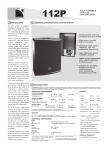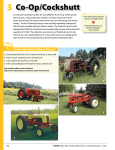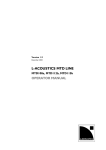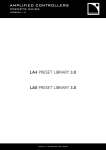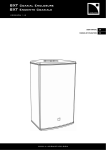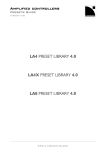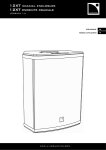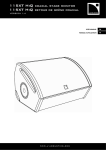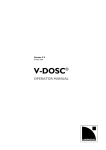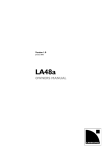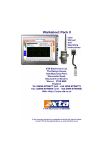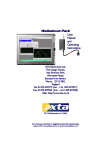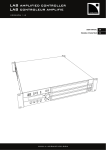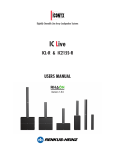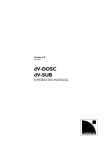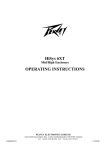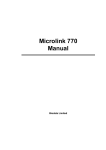Download L-ACOUSTICS XT LINE
Transcript
Version 1.1 February 2003 L-ACOUSTICS XT LINE 112XT, 115XT OPERATOR MANUAL FOREWORD Thank you for purchasing the 112XT or 115XT sound reinforcement system. This manual is intended to provide you with the information you require to install and operate your XT loudspeaker enclosure in a wide variety of professional sound reinforcement applications. Specific information and recommendations are included regarding system design, sound design and installation. We are confident that the information provided in this manual will be sufficient for most applications, however, should you require further assistance your distributor or L-ACOUSTICS® are available to provide additional technical support. MANUAL ORGANIZATION ! The Introduction gives a brief presentation of coaxial technology and the XT system. ! Chapter 1 introduces the 112XT and 115XT loudspeaker enclosures plus accessories ! Chapter 2 discusses 112XT and 115XT power amplification and cabling ! Chapter 3 describes preset selection and system operation ! Chapter 4 discusses sound design aspects ! Chapter 5 describes 112XT or 115XT installation procedures ! Chapter 6 discusses XT system operation and maintenance procedures ! Chapter 7 gives 112XT and 115XT specifications L-ACOUSTICS XT Manual V1.1 2/11/2003 1 L-ACOUSTICS XT Manual V1.1 2/11/2003 2 TABLE OF CONTENTS FOREWORD..............................................................................................................................................1 MANUAL ORGANIZATION....................................................................................................................1 TABLE OF CONTENTS............................................................................................................................3 LIST OF FIGURES.....................................................................................................................................4 LIST OF TABLES ......................................................................................................................................4 0. INTRODUCTION .................................................................................................................................5 1. THE XT SYSTEM..................................................................................................................................6 1.1 XT SYSTEM COMPONENTS......................................................................................................................... 6 1.2 XT OVERVIEW............................................................................................................................................. 9 1.3 112XT SPECIFICATIONS ............................................................................................................................ 10 1.4 115XT SPECIFICATIONS ............................................................................................................................ 11 2. POWERING XT ..................................................................................................................................12 2.1 POWERING 112XT.................................................................................................................................... 12 2.2 POWERING 115XT.................................................................................................................................... 14 2.3 CONNECTORS AND CABLES ..................................................................................................................... 17 3. XT CONTROL AND PROCESSING..................................................................................................17 3.1 GENERAL DESCRIPTION OF XT PRESETS .................................................................................................. 18 3.2 XT PRESET POLICY .................................................................................................................................... 18 3.3 GUIDELINES REGARDING SYSTEM PROTECTION..................................................................................... 19 3.4 XT PRESET LIBRARIES............................................................................................................................... 20 4. SOUND DESIGN ................................................................................................................................26 4.1 APPLICATIONS ........................................................................................................................................... 26 4.2 AIMING XT ENCLOSURES ......................................................................................................................... 26 4.3 ARRAYING XT ENCLOSURES ..................................................................................................................... 27 4.4 PREDICTING XT COVERAGE ..................................................................................................................... 30 4.5 DISTRIBUTED SOUND REINFORCEMENT................................................................................................. 30 4.5.1 OVERHEAD DISTRIBUTED SYSTEMS ............................................................................................ 30 4.5.2 DELAY SYSTEMS .............................................................................................................................. 30 4.5.3 COMPLEMENTARY FILL ................................................................................................................. 31 4.6 FRONT-OF-HOUSE (FOH) APPLICATIONS ................................................................................................ 32 4.7 STAGE MONITORING................................................................................................................................ 32 4.8 USING XT WITH SUBWOOFERS............................................................................................................... 34 4.8.1 COMBINING XT WITH SUBWOOFERS ........................................................................................ 35 4.8.2 GROUND STACKED SYSTEMS....................................................................................................... 35 4.8.3 SEPARATE FLOWN XT ARRAY WITH GROUND STACKED SUBWOOFERS ............................. 35 5. INSTALLATION PROCEDURES .......................................................................................................37 5.1 ETR112XT, ETR115XT U-BRACKET ATTACHMENT .................................................................................. 37 5.2 CPL112XT, CPL115XT COUPLING ADAPTER BAR ATTACHMENT ............................................................. 38 5.3 XTLIFTBAR ATTACHMENT ........................................................................................................................ 40 5.4 SAFETY RULES ........................................................................................................................................... 40 6. XT SYSTEM OPERATION .................................................................................................................41 6.1 RECOMMENDED MAINTENANCE PROCEDURES ..................................................................................... 41 6.2 SPARE PARTS.............................................................................................................................................. 42 7. SPECIFICATIONS ..............................................................................................................................43 7.1 112XT ELEMENT SPECIFICATIONS ........................................................................................................... 43 7.2 115XT ELEMENT SPECIFICATIONS ........................................................................................................... 47 L-ACOUSTICS XT Manual V1.1 2/11/2003 3 LIST OF FIGURES Figure 1: XT System Components .................................................................................................................... 8 Figure 2: 112XT Enclosure.............................................................................................................................. 10 Figure 3: 115XT Enclosure.............................................................................................................................. 11 Figure 4: MLS switches on the rear panel of L-ACOUSTICS LA24a, LA48a amplifiers.................................. 14 Figure 5: L-ACOUSTICS preset library for XTA DP224 ................................................................................ 21 Figure 6: L-ACOUSTICS preset library for XTA DP226 ................................................................................ 22 Figure 7: L-ACOUSTICS preset library for BSS FDS-334 Minidrive ............................................................... 23 Figure 8: L-ACOUSTICS preset library for BSS FDS-336 Minidrive ............................................................... 24 Figure 9: L-ACOUSTICS preset library for BSS FDS-366 Omnidrive Compact Plus .................................... 25 Figure 10: General guidelines for aiming XT enclosures ................................................................................. 27 Figure 11: SPL mappings at octave band frequencies for a single XT enclosure............................................. 27 Figure 12: SPL mappings at octave band frequencies for two XT enclosures with 0.5 metre spacing........... 28 Figure 13: SPL mappings at octave band frequencies for two XT enclosures with 3 metre spacing.............. 28 Figure 14: General guidelines for arraying XT enclosures.. ............................................................................ 29 Figure 15: SPL mappings at octave band frequencies for four XT enclosures with 0.5 metre spacing........... 29 Figure 16: L-ACOUSTICS Subwoofer Continuous Unweighted SPL Comparison......................................... 34 Figure 17: Illustration of subwoofer time alignment........................................................................................ 36 Figure 18: ETR112XT, ETR115XT U-bracket installation procedure ............................................................ 38 Figure 19: CPL112XT, CPL115XT coupling adapter installation procedure.................................................. 39 Figure 20: XTLIFTBAR installation procedure ................................................................................................ 40 Figure 21: 112XT Line Drawing ...................................................................................................................... 44 Figure 22: 112XT + ETR112XT Line Drawing............................................................................................... 45 Figure 23: 112XT + XTLIFTBAR Line Drawing ............................................................................................. 45 Figure 24: 112XT + ETR112XT + 112CPLXT Line Drawing (0 degree) ..................................................... 46 Figure 25: 112XT + ETR112XT + 112CPLXT Line Drawing (30 degrees).................................................. 46 Figure 26: 115XT Line Drawing ...................................................................................................................... 48 Figure 27: 115XT + ETR115XT Line Drawing............................................................................................... 49 Figure 28: 115XT + XTLIFTBAR Line Drawing ............................................................................................. 49 Figure 29: 115XT + ETR115XT + 115XTCPL Line Drawing (0 degrees).................................................... 50 Figure 30: 115XT + ETR115XT + 115XTCPL Line Drawing (30 degrees).................................................. 50 LIST OF TABLES Table 1: Load and Power Ratings for 112XT .................................................................................................. 12 Table 2: Recommended power amplification and MLS switch settings for 112XT low section ..................... 13 Table 3: Recommended power amplification and MLS switch settings for 112XT high section .................... 13 Table 4: Recommended MLS switch settings for powering 112XT................................................................ 14 Table 5: Load and Power Ratings for 115XT .................................................................................................. 14 Table 6: Recommended power amplification and MLS switch settings for 115XT low section ..................... 15 Table 7: Recommended power amplification and MLS switch settings for 115XT high section .................... 15 Table 8: Recommended MLS switch settings for powering 115XT................................................................ 15 Table 9: Output Power Ratings and MLS Switch Settings for L-ACOUSTICS LAa Amplifiers ....................... 16 Table 10: Maximum Recommended Length for Damping Factor > 20.......................................................... 17 Table 11: Nominal floor monitor distance and monitor separation versus performer height ........................ 33 Table 12: L-ACOUSTICS Subwoofer Specification Summary......................................................................... 34 L-ACOUSTICS XT Manual V1.1 2/11/2003 4 0. INTRODUCTION Effectively covering an audience is the goal of any sound reinforcement system design. This is straightforward in small spaces where a left/right stereo configuration is suitable provided that the available power is sufficient, i.e., a stereo pair of loudspeakers is a relatively easy system to install and the results are fairly predictable. Things become more complex when larger audience area coverage is required and there are two possible approaches: 1) Multiplying the number of sound sources by dividing the audience into areas which are covered by individual sources. In this case, the Haas effect is exploited and the goal is to reduce audible interference effects by dissociating or decoupling the individual sound sources (delay lines can also be introduced to provide proper localization). This is the distributed sound reinforcement, or multiple sound source approach, and the XT line of enclosures is highly suited for this type of sound design. 2) Coupling a number of individual sound sources to form a loudspeaker array, with the objective that each array becomes the equivalent of a single sound source. For the second approach, conditions for achieving proper coupling of individual arrayed sound sources have been defined by Dr. Christian Heil and Professor Marcel Urban, in "Sound Fields Radiated By Multiple Sound Source Arrays" (AES paper preprint 3269, presented at the 92nd AES convention in Vienna, 1992). Additional conditions were published in the AES preprint ''Wavefront Sculpture Technology'' (WST) that was presented at the 111th Convention, NYC, 2001 (preprint 5488). The theory that was developed defines the acoustic coupling conditions required for effectively arraying individual sound sources. These conditions are satisfied by the ARCS®, dV-DOSC™ and V-DOSC® products which are intended for medium- to large-scale sound reinforcement applications. However, in most cases, it is not feasible to meet WST criteria while at the same time having a sufficient level of versatility for small- to medium-scale applications. In other words, if a product is to be arrayable, it typically leads to an enclosure design that cannot be used in single or very small configurations. A different set of loudspeaker enclosure design specifications apply that are more suited to the multiple source sound design approach. The L-ACOUSTICS approach to distributed sound reinforcement using multiple sound sources starts with the specification that each individual loudspeaker enclosure should behave as a totally coherent source. This criterion can be achieved using coaxial components which are well-suited to the design of highly versatile, small format systems. The use of coaxial components has been popularized over the years by a famous British manufacturer for studio monitoring applications – to the best of our knowledge, L-ACOUSTICS was the first manufacturer to use coaxial technology in professional sound reinforcement applications and the current XT line is a continuation of the heritage that was introduced in 1989. Coaxial, dual concentric components provide a smooth transition between the LF and HF sections since, by definition, the directivity of the two transducers is matched at the crossover frequency. In addition, the directivity is horizontally, vertically and diagonally symmetric (axi-symmetric). This results in true, single source behavior and the performance obtained is superior in terms of coherence when compared with any combination of two independent sound sources (separate woofer plus hornloaded compression driver, for example). This is the case even if the independent sources are designed to provide the same directivity behavior (which is rarely the case) since the acoustic centers of the two sources are not located at the same physical location. Other benefits obtained using the coaxial, axi-symmetric configuration are smooth acoustical impedance loading for the compression driver and a short time window of reflections which is far more acceptable than the longer reflection sequences that are produced by traditional horn designs. In addition, the wavefront radiated by an axi-symmetric sound source has directivity that is smoothly increasing with frequency which helps to match the acoustical environment of a typical auditorium. Normally, the reverberation time in auditoria decreases smoothly above 1 kHz and at greater distances in the venue, the low frequency energy is fairly constant due to the reverberant field. L-ACOUSTICS XT Manual V1.1 2/11/2003 5 Loudspeaker focus or aiming can be adjusted so that maximum HF energy is directed towards the farthest listening areas, therefore balancing the SPL attenuation with distance that occurs in the direct field. At closer listening positions, the off-axis attenuation at higher frequencies provides a similar tonal balance and the attenuation with distance is less. The coaxial configuration therefore provides the optimum directivity required in order to obtain even coverage and constant tonal balance in a typical semi-reverberant auditorium. Extensive sound design and installation experience acquired by L-ACOUSTICS over the years confirms this and we are confident that coaxial, axi-symmetric loudspeaker enclosures are the best tools for multiple source, distributed sound design. The coaxial performance of the 112XT and 115XT loudspeaker enclosures provide the basic starting tools for distributed sound reinforcement design. 1. THE XT SYSTEM The XT line consists of: 112XT, 115XT loudspeaker enclosures, XT rigging accessories and SB115, SB118, SB218 or dV-SUB subwoofers. OEM factory presets are provided for approved digital signal processors (XTA DP224, DP226 and BSS 366). Please note that amplifier racks plus loudspeaker cables are not specified but should meet the minimum specification requirements outlined below. 1.1 XT SYSTEM COMPONENTS LOUDSPEAKER ENCLOSURES (1) 112XT Active 2-way coaxial loudspeaker with 90 degree axi-symmetrical coverage, containing 12” loudspeaker, 1.4” exit high frequency compression driver (2) 115XT Active 2-way coaxial loudspeaker with 80 degree axi-symmetrical coverage, containing 15” loudspeaker, 1.4” exit high frequency compression driver SUBWOOFER ENCLOSURES (3) SB115 Front-loaded, bass-reflex design, single 15’’ subwoofer for low frequency extension (4) SB118 Dual-vented bandpass-loaded, single 18’’ subwoofer for high level, extended bandwidth (5) SB218 Front-loaded, bass-reflex design, dual 18’’ subwoofer for high level, extended bandwidth (6) dV-SUB Dual-vented bandpass-loaded triple 15” subwoofer for high level, low frequency extension For more information concerning SB115, SB118 and SB218 subwoofer enclosures please consult the SB Subwoofer User’s Manual L-ACOUSTICS XT Manual V1.1 2/11/2003 6 XT RIGGING ACCESSORIES (7) ETR112XT Adjustable U-Bracket for ceiling, wall or scaffold mounting of the 112XT in either horizontal or vertical orientations (8) CPL112XT Coupling adapter bars used in conjunction with ETR112XT to array two 112XT enclosures vertically with independent tilt adjustment for both enclosures (9) ETR115XT Adjustable U-Bracket for ceiling, wall or scaffold mounting of the 115XT in either horizontal or vertical orientations (10) CPL115XT Coupling adapter bars used in conjunction with ETR115XT to array two 115XT enclosures vertically with independent tilt adjustment for both enclosures (11) XTLIFTBAR Allows for single point rigging of 112XT or 115XT loudspeaker enclosures with 5 pick points available for tilt adjustment (12) PION 2 Double stud Aeroquip flytrack fitting-to-ring for permanent installation of 112XT or 115XT enclosures or for use in conjunction with ETR112XT or ETR115XT as a safety attachment LOUDSPEAKER CABLES (13) F-CABLE (SP7, SP25) Loudspeaker cable, 4 conductor, 4mm2 conductor cross-section, 7 m (20 ft) or 25 m (80 ft) length, equipped with 2 x Speakon connectors (14) F-LINK CABLE (SP.7) Loudspeaker link cable, 4 conductor, 4mm2 conductor cross-section, 0.7 m (2 ft) length, equipped with 2 x Speakon connectors (for paralleling XT enclosures). 112XT 115XT L-ACOUSTICS XT Manual V1.1 2/11/2003 7 ETR112XT ETR115XT CPL112XT CPL115XT XTLIFTBAR PION2 F-CABLE DO7 F-LINK CABLE DO.7 Figure 1: XT System Components L-ACOUSTICS XT Manual V1.1 2/11/2003 8 1.2 XT OVERVIEW L-ACOUSTICS 112XT or 115XT loudspeaker enclosures are intended for distributed sound reinforcement and can be used for either high performance touring or fixed installation. Both XT loudspeaker enclosures feature highly-advanced coaxial components and rigging accessories while also benefiting from the flexibility afforded by OEM digital presets. The 112XT is an active 2-way loudspeaker containing a 1.4" exit compression driver that is directly loaded by the 12" loudspeaker in a coaxial configuration while the 115XT features a 15” loudspeaker. As discussed in the introduction, advantages of the coaxial approach include: single point source radiation and excellent phase response, total wavefront coherency at all frequencies and axisymmetrical directivity that produces identical horizontal and vertical coverage. Coaxial design also provides LF/HF superimposed dispersion characteristics that are free of polar lobing effects typical of traditional horn and woofer combinations. The end result is natural, studio monitor level sound quality, ideal for proximity use and perfectly matching semi-reverberant environments. The 112XT or 115XT are ideal for distributed sound reinforcement and can also be used in medium power front-of-house (FOH) applications for theatres, clubs, multi-purpose venues or corporate events. Examples of distributed systems include delay rings for large-scale installations, surround effects channels for theatre or multimedia, distributed reinforcement for sports venues, and delays for speech reinforcement in convention centre ballrooms. Although optimized for single operation, 112XT or 115XT loudspeakers can be used in vertical arrays of two enclosures to enhance either SPL or coverage. Due to their compact, wedge-shaped format and axi-symmetrical directivity, XT enclosures also provide an exceptionally high performance floor monitor solution. When used with the SB118 (or other L-ACOUSTICS subwoofers), XTs are also excellent for side fill and drum monitoring applications. OEM factory presets are available for approved digital processors, providing flexible solutions for a wide variety of 2- and 3-way operating modes. For 2-way operation, three types of presets are provided: FRONT presets are for standalone FOH operation (without subwoofers) where low and high frequency shelving equalization provides a frequency response contour suitable for music applications. FILL presets provide nominally flat response for use in speech reinforcement and classical music applications or when XT enclosures are used as a close proximity fill enclosure. Both FRONT and FILL presets are derived under freefield measurement conditions. MONITOR presets include additional low frequency equalization to account for half-space loading conditions and are intended for floor monitoring applications or fixed installations where the XT is wall- or ceiling-mounted. MONITOR presets are derived under half-space measurement conditions. A variety of 3-way presets are provided for use of the 112XT or 115XT with SB115, SB118, SB218 or dV-SUB subwoofers. Standard 3W presets utilize a complimentary 100 Hz crossover point for the XT and its companion subwoofer and are recommended for closely coupled applications. Alternatively, when XT enclosures are flown and subwoofers are ground stacked, 3WX presets can be employed where an 80 Hz low pass filter is applied to the subwoofers and 112XT or 115XT low frequency response extends to 55 or 50 Hz, respectively. Pole mount sockets and side-mounted fly track sections are included as standard on XT enclosures and optional rigging accessories include an adjustable U-bracket for ceiling, wall or scaffold mounting (vertical or horizontal orientations), coupling adapter bars for vertical coupling of two XT enclosures (independent tilt adjustment for each enclosure) and the XTLIFTBAR accessory for single point rigging (5 pick points available allowing for tilt adjustment). L-ACOUSTICS XT Manual V1.1 2/11/2003 9 1.3 112XT SPECIFICATIONS The 112XT is an active, two-way, coaxial full range loudspeaker containing one direct radiating, bass reflex-loaded, 12 inch low frequency transducer and one 1.4 inch exit, 3 inch voice coil diameter, titanium alloy diaphragm compression driver. As a full range system, the frequency response is 65 Hz to 18 kHz with less than ± 3 dB variation and the usable bandwidth is 55 Hz to 18 kHz (-10 dB). The cone body of the low frequency component provides pattern control loading of the compression driver and yields a 90-degree (± 20 degrees) conical dispersion pattern that is axi-symmetrical. The crossover point between low and high frequency components is 1 kHz with 24 dB per octave Linkwitz-Riley characteristics. Long term power handling is 290 Wrms for the low section and 135 Wrms for the high section at a nominal 8 ohm impedance. Connection to the loudspeaker is made via two parallel 4-pin Neutrik Speakon connectors. The 112XT has a truncated wedge shape with a curved front profile. Dimensions are 54 cm (21.3 in) high, 41 cm (16.1 in) wide at the front of the enclosure, 16.5 cm (6.5 in) wide at the rear of the enclosure and 37.5 cm (14.8 in) deep. When used on its rear side, the front baffle of the enclosure is oriented at a 45 degree angle with respect to vertical, allowing the enclosure to be used as a floor monitor. Enclosure weight is 27 kg (59.5 lbs). Cabinet construction consists of 30 mm (1.18 in) and 18 mm (0.70 in) Baltic birch plywood with internal steel bracing and joints that are sealed, screwed and rabbeted. The finish is maroon-gray high resilient paint. The front of the enclosure is protected by a black powder-coated, 1.5 mm (0.06 in) thick steel grill that is covered with 10 mm (0.4 in) thick acoustically transparent open cell foam. The 112XT has two side-recessed flytrack sections and 36 mm (1.42 in) diameter pole mount sockets mounted on the top and bottom sides. Pole mount sockets function with the ETR112XT U-bracket accessory for rigging the enclosure in either horizontal or vertical orientations, providing angular adjustment with 10 degree resolution. Two CPL112XT coupling adapter bars can be used in conjunction with the ETR112XT U-bracket, allowing two 112XT enclosures to be flown vertically while providing independent tilt adjustment for each enclosure. The XTLIFTBAR accessory functions with either of the pole mount sockets and provides five attachment points for rigging purposes. The 112XT loudspeaker is used with an approved digital processor with OEM factory presets for active 2-way operation or 3-way operation in conjunction with additional subwoofers (L-ACOUSTICS SB115, SB118, SB218 or dV-SUB). Figure 2: 112XT Enclosure L-ACOUSTICS XT Manual V1.1 2/11/2003 10 1.4 115XT SPECIFICATIONS The 115XT is an active, two-way, coaxial full range loudspeaker containing one direct radiating, bass reflex-loaded, 15 inch low frequency transducer and one 1.4 inch exit, 3 inch voice coil diameter, titanium alloy diaphragm, neodymium compression driver. As a full range system, frequency response is 60 Hz to 18 kHz with less than ± 3 dB variation and the usable bandwidth is 50 Hz to 18 kHz (-10 dB). The cone body of the low frequency component provides pattern control loading of the compression driver and yields an 80-degree (± 20 degree) conical dispersion pattern that is axi-symmetrical. The crossover point between low and high frequency components is 1 kHz with 24 dB per octave Linkwitz-Riley characteristics. Long term power handling is 250 Wrms for the low section and 85 Wrms for the high section at a nominal 8 ohm impedance. Connection to the loudspeaker is made via two parallel 4-pin Neutrik Speakon connectors. The 115XT enclosure has a truncated wedge shape with a curved front profile. Dimensions are 58 cm (22.8 in) high, 44 cm (17.3 in) wide at the front of the enclosure, 16.7 cm (6.6 in) wide at the rear of the enclosure and 47.5 cm (18.7 in) deep. When used on its rear side, the front baffle of the 115XT is oriented at a 41 degree angle with respect to vertical, allowing the enclosure to be used as a floor monitor. Enclosure weight is 29.5 kg (65.0 lbs). Cabinet construction consists of 30 mm (1.18 in) and 18 mm (0.70 in) Baltic birch plywood with internal steel bracing and joints that are sealed, screwed and rabbeted. The finish is maroon-gray high resilient paint. The front of the enclosure is protected by a black powder-coated, 1.5 mm (0.06 in) thick steel grill that is covered with 10 mm (0.39 in) thick acoustically transparent open cell foam. The 115XT has two side-recessed flytrack sections and 36 mm (1.42 in) diameter pole mount sockets mounted on the top and bottom sides. Pole mount sockets function with the ETR115XT U-bracket accessory for rigging the enclosure in either horizontal or vertical orientations, providing angular adjustment with 10 degree resolution. Two CPL115XT coupling adapter bars can also be used in conjunction with the ETR115XT U-bracket, allowing two 115XT enclosures to be flown vertically while providing independent tilt adjustment for each enclosure. The XTLIFTBAR accessory functions with either of the pole mount sockets and provides five attachment points for rigging purposes. The 115XT loudspeaker is used with an approved digital processor with OEM factory presets for active 2-way operation or 3-way operation in conjunction with additional subwoofers (L-ACOUSTICS SB115, SB118, SB218 or dV-SUB). Figure 3: 115XT Enclosure L-ACOUSTICS XT Manual V1.1 2/11/2003 11 2. POWERING XT It is important that power amplifiers with sufficient power are used to power the 112XT or 115XT since headroom is less likely to damage loudspeaker components than clipping. Apart from normal standards regarding construction, protection, cooling and damping factor that are expected of any professional sound reinforcement amplifier, the XT system has been calibrated to be used with amplifiers with the following specifications: GAIN STRUCTURE All amplifiers should have 32 dB gain for all sections (sub, low and high). The limiter thresholds and output channel gains of OEM digital crossover presets have been adjusted to be used with amplifiers having 32 dB gain. LIMITERS Peak limiters on all amplifier outputs with soft clipping characteristics; attack time less than 3msec COOLING Temperature speed-controlled fan recommended In practice, L-ACOUSTICS specifies power amplifiers with output power equivalent to twice the RMS power handling for the low section and equivalent to the peak power handling for the high section. These requirements typically allow the same amplifier to be used for both sections since the drive level for the HF section is attenuated relative to the LF section to account for efficiency differences (i.e., full continuous power will never be delivered to the HF section due to this attenuation). When the same amplifier is used for the HF section, the extra available power then translates into headroom for improved high frequency transient response. Sections 2.1 and 2.2 give a summary of rms and peak power handling along with recommended power amplifier output specifications for operation of single 112XT or 115XT enclosures or multiple XT enclosures in parallel. 2.1 POWERING 112XT Continuous (rms) and peak power handling ratings for the 112XT are as follows: LF Section: 48 volts rms long term (pink noise with 6 dB crest factor) 290 Watts (continuous), 1160 Watts (peak) at 8 ohms HF Section: 33 volts rms long term (pink noise with 6 dB crest factor) 135 Watts (continuous), 540 Watts (peak) at 8 ohms Table 1: Load and Power Ratings for 112XT 112XT ENCLOSURE RATINGS ONE 112XT SECTION TWO 112XT THREE 112XT FOUR 112XT LOAD RMS PEAK REC'D LOAD RMS PEAK REC'D LOAD RMS PEAK REC'D LOAD RMS PEAK REC'D LOW 8 290 1160 580 4 580 2320 1160 2.7 870.0 3480 1740 2 1160 4640 2320 HIGH 8 135 540 540 4 270 1080 1080 2.7 400.0 1600 1600 2 540 2160 2160 For amplifying 2 112XT in parallel, the recommended amplifier specifications are: * LOW Amplifier Output Power: 1160 W into 4 ohms * HIGH Amplifier Output Power: 1080 W into 4 ohms For amplifying 3 112XT in parallel, the recommended amplifier specifications are: * LOW Amplifier Output Power: 1740 W into 2.7 ohms * HIGH Amplifier Output Power: 1600 W into 2.7 ohms L-ACOUSTICS XT Manual V1.1 2/11/2003 12 For amplifying 4 112XT in parallel, the recommended amplifier specifications are: * LOW Amplifier Output Power: 2320 W into 2 ohms * HIGH Amplifier Output Power: 2160 W into 2 ohms Based on these specifications, recommended L-ACOUSTICS LA power amplifier specifications and MLS switch settings are summarized in Tables 2 and 3. In these tables, boldface settings indicate a good power match based on the recommended power amplifier specification. Table 2: Recommended power amplification and MLS switch settings for 112XT low section 112XT LOW SECTION AMPLIFIER OUTPUT POWER REC'D POWER (MLS SETTING) LOAD POWER (ohms) (W) 2 2320 LA 17a LA 24a do not use do not use LA 48a 2400 (-2 dB) 2.7 1740 4 1080 1635 2130 (0 dB) (0 dB) (-2 dB) 840 1300 1600 (0 dB) (-2 dB) (-2 dB) 430 700 820 (0 dB) (-2 dB) (-2 dB) 1160 8 580 Table 3: Recommended power amplification and MLS switch settings for 112XT high section 112XT HI SECTION AMPLIFIER OUTPUT POWER REC'D POWER (MLS SETTING) LOAD REC'D (ohms) POWER 2 2160 LA 17a LA 24a do not use do not use LA 48a 2000 (-4 dB) 2.7 4 8 1600 1080 540 1080 1635 1665 (0 dB) (0 dB) (-4 dB) 840 1300 1000 (0 dB) (-2 dB) (-4 dB) 430 700 520 (0 dB) (-2 dB) (-4 dB) L-ACOUSTICS LA amplifier MLS switch settings for powering the 112XT are summarized in Table 4 and Figure 4 shows the location of MLS switches on the LA24a and LA48a rear panel. L-ACOUSTICS XT Manual V1.1 2/11/2003 13 Table 4: Recommended MLS switch settings for powering 112XT MLS SWITCH SETTING LA17a LA24a LA48a 0 dB -2 dB -2 dB 0 dB -2 dB -4 dB 112XT LO SECTION 112XT HI SECTION Figure 4: MLS switches on the rear panel of L-ACOUSTICS LA24a, LA48a amplifiers 2.2 POWERING 115XT Continuous (rms) and peak power handling ratings for the 115XT are as follows: LF Section: 45 volts rms long term (pink noise with 6 dB crest factor) 250 Watts (continuous), 1000 Watts (peak) at 8 ohms HF Section: 26 volts rms long term (pink noise with 6 dB crest factor) 85 Watts (continuous), 350 Watts (peak) at 8 ohms Table 5: Load and Power Ratings for 115XT 115XT ENCLOSURE RATINGS ONE 115XT SECTION TWO 115XT THREE 115XT FOUR 115XT LOAD RMS PEAK REC'D LOAD RMS PEAK REC'D LOAD RMS PEAK REC'D LOAD RMS PEAK REC'D LOW 8 250 1000 500 4 500 2000 1000 2.7 750.0 3000 1500 2 1000 4000 2000 HIGH 8 85 350 350 4 170 700 700 2.7 250.0 1000 1000 2 350 1400 1400 For amplifying 2 115XT in parallel, the recommended amplifier specifications are: * LOW Amplifier Output Power: 1000 W into 4 ohms * HIGH Amplifier Output Power: 700 W into 4 ohms For amplifying 3 115XT in parallel, the recommended amplifier specifications are: * LOW Amplifier Output Power: 1500 W into 2.7 ohms * HIGH Amplifier Output Power: 1000 W into 2.7 ohms For amplifying 4 115XT in parallel, the recommended amplifier specifications are: * LOW Amplifier Output Power: 2000 W into 2 ohms * HIGH Amplifier Output Power: 1400 W into 2 ohms L-ACOUSTICS XT Manual V1.1 2/11/2003 14 Based on these specifications, recommended L-ACOUSTICS LA power amplifier specifications and MLS switch settings are summarized below in Tables 6 and 7. Table 6: Recommended power amplification and MLS switch settings for 115XT low section 115XT LOW SECTION AMPLIFIER OUTPUT POWER REC'D POWER (MLS SETTING) LOAD POWER (ohms) (W) 2 2000 LA 17a LA 24a LA 48a 2000 do not use do not use (-4 dB) 2.7 1500 4 1080 1635 1665 (0 dB) (0 dB) (-4 dB) 840 1300 1000 (0 dB) (-2 dB) (-4 dB) 1000 8 430 700 520 (0 dB) (-2 dB) (-4 dB) 500 Table 7: Recommended power amplification and MLS switch settings for 115XT high section 115XT HI SECTION AMPLIFIER OUTPUT POWER REC'D POWER (MLS SETTING) LOAD REC'D (ohms) POWER 2 2.7 4 8 1400 1000 700 350 LA 17a LA 24a LA 48a 1200 1400 1660 (0 dB) (-4 dB) (-5 dB) 1080 1180 1380 (0 dB) (-4 dB) (-5 dB) 840 750 830 (0 dB) (-4 dB) (-5 dB) 430 400 430 (0 dB) (-4 dB) (-5 dB) MLS switch settings for powering the 115XT are summarized in Table 8. Table 8: Recommended MLS switch settings for powering 115XT 115XT LO SECTION 115XT HI SECTION L-ACOUSTICS XT Manual V1.1 MLS SWITCH SETTING LA17a LA24a LA48a 0 dB -2 dB -4 dB 0 dB -4 dB -5 dB 2/11/2003 15 L-ACOUSTICS LA 15a POWER MATRIX L-ACOUSTICS LA 17a POWER MATRIX MLS SWITCH SETTING LOAD CONFIGURATION -3 dB 0 dB 16 ohms Quad (4 channel) 95 200 8 ohms Quad (4 channel) 200 4 ohms Quad (4 channel) 380 2.7 ohms Quad (4 channel) 2 ohms Quad (4 channel) MLS SWITCH SETTING LOAD CONFIGURATION -3 dB 0 dB 16 ohms Stereo (2 channel) 110 215 370 8 ohms Stereo (2 channel) 220 430 600 4 ohms Stereo (2 channel) 430 840 460 2.7 ohms Stereo (2 channel) 720 1080 500 2 ohms Stereo (2 channel) 870 1200 L-ACOUSTICS LA 24a POWER MATRIX L-ACOUSTICS LA 48a POWER MATRIX MLS SWITCH SETTING LOAD CONFIGURATION MLS SWITCH SETTING -5 dB -4 dB -2 dB 0 dB 16 ohms Stereo (2 channel) 160 200 340 520 8 ohms Stereo (2 channel) 300 400 700 4 ohms Stereo (2 channel) 600 750 2.7 ohms Stereo (2 channel) 1000 2 ohms Stereo (2 channel) 1200 LOAD CONFIGURATION -5 dB -4 dB -2 dB 0 dB 16 ohms Stereo (2 channel) 220 260 410 650 1100 8 ohms Stereo (2 channel) 430 520 820 1300 1300 1500 4 ohms Stereo (2 channel) 830 1000 1600 2300 1180 1465 1635 2.7 ohms Stereo (2 channel) 1380 1665 2130 2700 1400 1550 1700 2 ohms Stereo (2 channel) 1660 2000 2400 2900 Table 9: Output Power Ratings and MLS Switch Settings for L-ACOUSTICS LAa Amplifiers L-ACOUSTICS XT Manual V1.1 2/11/2003 16 2.3 CONNECTORS AND CABLES 112XT and 115XT are supplied with dual NL4 Speakon connectors. The two Speakon connectors are internally wired in parallel, allowing for loop through connection and parallel operation of multiple XT enclosures. Speakon connectors are wired as follows: 1+ 12+ 2- = = = = LF+ LF HF+ HF – In order to preserve high damping factor (essential to the sonic qualities of the system and to prevent overshoot of cone displacement which can result in mechanical damage), it is desirable to keep loudspeaker cables as short as possible and with a gauge offering low resistance per unit length. The following chart provides information regarding the minimum wire cross-section versus length: Table 10: Maximum Recommended Length for Damping Factor > 20 Cross Section Gauge 8 ohms 4 ohms Metric (mm2) Imperial Metric Imperial Metric Imperial 2.5 13 30 m 100 ft 15 m 45 ft 4 11 50 m 150 ft 25 m 75 ft 6 8 75 m 225 ft 37 m 110 ft 10 6 120 m 360 ft 60 m 180 ft As standard, L-ACOUSTICS F-CABLE (SP7, SP25) and F-LINK CABLE (SP.7) loudspeaker cables are 4 conductor cables with 4 mm2 conductor cross-section (11 gauge). SP25 cables can be used for 25 meter cable runs to power a 4 ohm load (2 x 112XT or 115XT enclosures in parallel) while maintaining a damping factor greater than 20. 3. XT CONTROL AND PROCESSING A digital processor is specified for use with XT enclosures in order to provide the following functions: crossover filtering, component time alignment, corrective component equalization, system protection and system equalization. OEM factory presets are provided for a number of approved digital processors including: BSS FDS-366 Omnidrive Compact Plus, BSS FDS-334 Minidrive, BSS FDS-336 Minidrive, XTA DP224 and XTA DP226. All presets (except for Minidrive) are distributed via PCMCIA card and can also be downloaded from the L-ACOUSTICS website (www.l-acoustics.com). Since the XTA DP226 is a 2 input by 6 output unit, the DP224 is 2 x 4, the FDS-334 is 2 x 4, the FDS336 is 2 x 6 and the FDS-366 is 3 x 6, exact internal wiring of your FOH drive rack and digital processor channel assignments will vary depending on the selected processor and the application. Carefully consider your flexibility requirements before selecting the type of processor to specify. NOTE: ALWAYS REFER TO THE PRESET DESCRIPTION SHEET FOR YOUR PROCESSOR WHEN SELECTING PRESETS AND CONFIGURING YOUR DRIVE RACK. L-ACOUSTICS XT Manual V1.1 2/11/2003 17 3.1 GENERAL DESCRIPTION OF XT PRESETS For 2-way operation, three types of presets are provided: FRONT presets are for standalone FOH operation (without subwoofers) where low and high frequency shelving equalization provides a frequency response contour suitable for music applications. FILL presets provide nominally flat response for use in speech reinforcement and classical music applications or when XT enclosures are used as a close proximity fill enclosure. FRONT and FILL presets are derived under freefield measurement conditions. MONITOR presets include additional low frequency equalization to account for half-space loading conditions and are intended for floor monitoring applications or fixed installations where the XT is wall- or ceiling-mounted. MONITOR presets are derived under half space measurement conditions. A variety of 3-way presets are provided for use of 112XT or 115XT loudspeaker enclosures with SB115, SB118, SB218 or dV-SUB subwoofers. Standard 3W presets utilize a complimentary 100 Hz crossover point for the XT and its companion subwoofer and are recommended for closely coupled applications. Alternatively, when XT enclosures are flown and subwoofers are ground stacked, 3WX presets can be employed where an 80 Hz low pass filter is applied to the subwoofers and 112XT or 115XT low frequency response extends to 55 or 50 Hz, respectively. 3.2 XT PRESET POLICY According to L-ACOUSTICS policy, key parameters are software-protected and preset data or passwords are not available in order to preserve quality control, confidentiality and to maintain the integrity of L-ACOUSTICS system presets. Restricting access to presets is in no way meant to restrict flexibility or the creative process – on the contrary, software-protected presets are intended to enhance creativity by ensuring quality control and repeatability. Extensive engineering and real world testing goes into determining optimum presets – detailed polar measurements and weighted spatial averaging are used to determine component equalization, time alignment, crossover points and crossover filter slopes, for example. As a result, L-ACOUSTICS presets give the user an optimum starting point – system tuning should be done using band attenuation, subwoofer time alignment and system equalization using input section parametric filters – not by altering presets for the following reason: Without proper instrumentation and spatial averaging, adjustments made at one location (e.g. the mix position) are not optimum at all other locations within the defined coverage region of the system. When made by ear, such adjustments are often misguided – the user may be in a local room mode (low frequency pressure maximum or minimum) and/or may be hearing a cancellation or addition due to crossover misalignment that sounds good at that specific location but what about all others? Meanwhile, the same result could have been achieved while preserving the power response of the system by using the correct crossover preset and a simple equalization cut or correct time alignment of subwoofers. Preset libraries are distributed via PCMCIA Card which are available from L-ACOUSTICS headquarters in France , L-ACOUSTICS US, L-ACOUSTICS UK or your L-ACOUSTICS distributor. Preset libraries and upgrades can also be downloaded from www.l-acoustics.com. L-ACOUSTICS XT Manual V1.1 2/11/2003 18 3.3 GUIDELINES REGARDING SYSTEM PROTECTION As standard, limit thresholds for XTA and BSS Processors are initially set at 3 dBu above the RMS power handling for both low and high sections of the 112XT and 115XT as follows: 112XT low section : +6 dBu 112XT high section : +3 dBu 115XT low section : +6 dBu 115XT high section : +2 dBu Amplifier input sensitivities (0 dB MLS switch setting) are as follows: LA17a : +5.5 dBu LA24a : +7.7 dBu LA48a : +9.5 dBu For the 112XT and 115XT low section, the +6 dBu limit threshold corresponds to 3 dBu above the RMS power handling of the low section as well as the input sensitivity of the L-ACOUSTICS LA17a (+5.5 dBu) and LA 24a (+7.7 dBu) so that system protection is performed by a combination of the clip limiting circuits of the amplifier and the output channel limiters of the digital signal processor. Note: L-ACOUSTICS recommends that LA power amplifier clip limiters be engaged at all times (CLIP switch depressed in the “IN” position). L-ACOUSTICS LA amplifier clip limiters are sonically transparent and function by monitoring the output signal and comparing the distortion produced between the input and output of the amplifier. If the distortion exceeds 1% THD for any reason (voltage or current clipping), the limiter reduces the input signal proportionally (2 msec attack, 150 msec release). Under normal operation, clip limiting is inaudible and L-ACOUSTICS recommends leaving the Channel A and B clip limiters switched ''on'' (rear panel button depressed) at all times. As shown in Sections 2.1 and 2.2, additional protection can be obtained by using the following MLS switch settings for power matching of the amplifier output to the power handling capacity of the XT low and high sections: 112XT LO SECTION 112XT HI SECTION MLS SWITCH SETTING LA17a LA24a LA48a 0 dB -2 dB -2 dB 0 dB -2 dB -4 dB 115XT LO SECTION 115XT HI SECTION MLS SWITCH SETTING LA17a LA24a LA48a 0 dB -2 dB -4 dB 0 dB -4 dB -5 dB For the 112XT and 115XT high section, the +3 dBu (112XT) or +2 dBu (115XT) limit thresholds correspond to 3 dBu above the RMS power handling of the high section and system protection is performed by the limiting circuitry of the digital signal processor. Example: For the 112XT, the high section limit threshold is set to 3 dBu below the peak power handling in order to provide secure operation, i.e, the RMS power handling is 135 W, peak power handling is 540 W and assuming 32 dB amplifier gain, these power ratings correspond to limit thresholds of 0 dBu (135 W) and +6 dBu (540 W). As standard, the 112XT HF limiter threshold is set to +3 dBu (3 dB less than the peak power handling). L-ACOUSTICS XT Manual V1.1 2/11/2003 19 Standard HF limiter thresholds for the 112XT and 115XT are suitable for most applications however the following adjustments can be made depending on the program content: 1) classical music - lots of transients, low RMS signal content increase standard HF limit threshold by 3 dB to correspond to the peak power handling (for example, 112XT HF limit threshold: +3 dBu -> +6 dBu) 2) rave/techno music - high RMS signal content, long duration decrease standard HF limit threshold by 3 dB to correspond to the RMS power handling (for example, 112XT HF limit threshold: +3 dBu -> 0 dBu) NOTE: Setting limit thresholds to the amplifier input sensitivity (or the rated power handling of the section being driven) is important since this calibrates the output meter display of the crossover to correspond to either the amplifier clip point or the rated power handling. This gives the system operator a direct visual indication as to how hard the system is being operated. 3.4 XT PRESET LIBRARIES As described in Section 3.2, three types of 2-way presets for 112XT and 115XT are provided (FRONT, FILL and MONITOR) while two types of 3-way presets are available for the use of XT enclosures with L-ACOUSTICS SB115, SB118, SB218 or dV-SUB subwoofers (3W and 3WX). All 2-way presets are configured in stereo 3-way mode, i.e., channel A and B Low/High outputs are on output channels 2 / 3 and 5 / 6, respectively. This means that drive racks do not require recabling when changing from 3-way to 2-way presets. In addition, for these 2way presets, channels 1 and 4 are unlocked and available for programming of passive fill loudspeakers, subwoofers or, alternatively, for monitoring input equalization when using the SMAART or SPECTRAFOO measurement systems. Note: for BSS FDS-366, 3 x 2-way presets are provided in memory locations 37-46. This channel configuration is recommended for 3 mix floor monitoring or Left/Centre/Right (LCR) applications. Please refer to the appropriate Preset Description Sheet (excel .XLS files) to assist in selecting the appropriate preset and as a reference for properly configuring crossover output channels for your drive rack or signal distribution system. Complete Preset Description Sheet excel files are available for download from www.lacoustics.com along with preset library data. As a quick reference, Figures 5-9 give channel assignments for XTA DP226, DP224 and BSS 334, 336, 366 respectively. L-ACOUSTICS XT Manual V1.1 2/11/2003 20 L-ACOUSTICS V7 0902 PRESETS for XTA DP 226 PRESET NAME PGM TYPE MEM OUT 1 (Source) OUT 2 (Source) OUT 3 (Source) OUT 4 (Source) OUT 5 (Source) OUT 6 (Source) ARCS 2W LO ARCS 2W HI 3-way stereo 3-way stereo 10 11 FULL (A) FULL (A) ARCS LOW (A) ARCS LOW (A) ARCS HI (A) ARCS HI (A) FULL (B) FULL (B) ARCS LOW (B) ARCS LOW (B) ARCS HI (B) ARCS HI (B) ARCS ARCS ARCS ARCS 3-way stereo 3-way stereo 3-way stereo 3-way stereo 12 13 14 15 SB218 (A) SB218 (A) dV-SUB (A) dV-SUB (A) ARCS LOW (A) ARCS LOW (A) ARCS LOW (A) ARCS LOW (A) ARCS HI (A) ARCS HI (A) ARCS HI (A) ARCS HI (A) SB218 (B) SB218 (B) dV-SUB (B) dV-SUB (B) ARCS LOW (B) ARCS LOW (B) ARCS LOW (B) ARCS LOW (B) ARCS HI (B) ARCS HI (B) ARCS HI (B) ARCS HI (B) 3-way stereo (not linked) 3-way stereo (not linked) 16 17 FULL (A) FULL (A) 115FM LOW (A) 115FM LOW (A) 115FM HI (A) 115FM HI (A) FULL (B) FULL (B) 115FM LOW (B) 115FM LOW (B) 115FM HI (B) 115FM HI (B) 3-way stereo 3-way stereo 3-way stereo 3-way stereo 18 19 20 21 SB115 (A) SB118 (A) SB218 (A) dV-SUB (A) 115FM LOW (A) 115FM LOW (A) 115FM LOW (A) 115FM LOW (A) 115FM HI (A) 115FM HI (A) 115FM HI (A) 115FM HI (A) SB115 (B) SB118 (B) SB218 (B) dV-SUB (B) 115FM LOW (B) 115FM LOW (B) 115FM LOW (B) 115FM LOW (B) 115FM HI (B) 115FM HI (B) 115FM HI (B) 115FM HI (B) 112XT 2W FILL 112XT 2W FRONT 112XT 2W MONITOR 3-way stereo 3-way stereo 3-way stereo (not linked) 22 23 24 FULL (A) FULL (A) FULL (A) 112XT LOW (A) 112XT LOW (A) 112XT LOW (A) 112XT HI (A) 112XT HI (A) 112XT HI (A) FULL (B) FULL (B) FULL (B) 112XT LOW (B) 112XT LOW (B) 112XT LOW (B) 112XT HI (B) 112XT HI (B) 112XT HI (B) 112XT 3W SB115 112XT 3WX SB115 112XT 3W SB118 112XT 3WX SB118 112XT 3W SB218 112XT 3WX SB218 112XT 3W dV-SUB 112XT 3WX dV-SUB 3-way stereo 3-way stereo 3-way stereo 3-way stereo 3-way stereo 3-way stereo 3-way stereo 3-way stereo 25 26 27 28 29 30 31 32 SB115 (A) SB115 (A) SB118 (A) SB118 (A) SB218 (A) SB218 (A) dV-SUB (A) dV-SUB (A) 112XT LOW (A) 112XT LOW (A) 112XT LOW (A) 112XT LOW (A) 112XT LOW (A) 112XT LOW (A) 112XT LOW (A) 112XT LOW (A) 112XT HI (A) 112XT HI (A) 112XT HI (A) 112XT HI (A) 112XT HI (A) 112XT HI (A) 112XT HI (A) 112XT HI (A) SB115 (B) SB115 (B) SB118 (B) SB118 (B) SB218 (B) SB218 (B) dV-SUB (B) dV-SUB (B) 112XT LOW (B) 112XT LOW (B) 112XT LOW (B) 112XT LOW (B) 112XT LOW (B) 112XT LOW (B) 112XT LOW (B) 112XT LOW (B) 112XT HI (B) 112XT HI (B) 112XT HI (B) 112XT HI (B) 112XT HI (B) 112XT HI (B) 112XT HI (B) 112XT HI (B) 115XT 2W FILL 115XT 2W FRONT 115XT 2W MONITOR 3-way stereo 3-way stereo 3-way stereo (not linked) 33 34 35 FULL (A) FULL (A) FULL (A) 115XT LOW (A) 115XT LOW (A) 115XT LOW (A) 115XT HI (A) 115XT HI (A) 115XT HI (A) FULL (B) FULL (B) FULL (B) 115XT LOW (B) 115XT LOW (B) 115XT LOW (B) 115XT HI (B) 115XT HI (B) 115XT HI (B) 115XT 3W SB115 115XT 3WX SB115 115XT 3W SB118 115XT 3WX SB118 115XT 3W SB218 115XT 3WX SB218 115XT 3W dV-SUB 115XT 3WX dV-SUB 3-way stereo 3-way stereo 3-way stereo 3-way stereo 3-way stereo 3-way stereo 3-way stereo 3-way stereo 36 37 38 39 40 41 42 43 SB115 (A) SB115 (A) SB118 (A) SB118 (A) SB218 (A) SB218 (A) dV-SUB (A) dV-SUB (A) 115XT LOW (A) 115XT LOW (A) 115XT LOW (A) 115XT LOW (A) 115XT LOW (A) 115XT LOW (A) 115XT LOW (A) 115XT LOW (A) 115XT HI (A) 115XT HI (A) 115XT HI (A) 115XT HI (A) 115XT HI (A) 115XT HI (A) 115XT HI (A) 115XT HI (A) SB115 (B) SB115 (B) SB118 (B) SB118 (B) SB218 (B) SB218 (B) dV-SUB (B) dV-SUB (B) 115XT LOW (B) 115XT LOW (B) 115XT LOW (B) 115XT LOW (B) 115XT LOW (B) 115XT LOW (B) 115XT LOW (B) 115XT LOW (B) 115XT HI (B) 115XT HI (B) 115XT HI (B) 115XT HI (B) 115XT HI (B) 115XT HI (B) 115XT HI (B) 115XT HI (B) 3W SB218 LO 3W SB218 HI 3W dV-SUB LO 3W dV-SUB HI 115FM 2W COUPLED 115FM 2WX SINGLE 115FM 3W SB115 115FM 3W SB118 115FM 3W SB218 115FM 3W dV-SUB Figure 5: L-ACOUSTICS preset library for XTA DP226 L-ACOUSTICS XT Manual V1.1 2/11/2003 21 L-ACOUSTICS V7 0902 PRESETS for XTA DP 224 PRESET NAME PGM TYPE MEM OUT 1 (Source) OUT 2 (Source) OUT 3 (Source) OUT 4 (Source) ARCS 2W LO ARCS 2W HI 2-way stereo 2-way stereo 10 11 ARCS LO (A) ARCS LO (A) ARCS HI (A) ARCS HI (A) ARCS LO (B) ARCS LO (B) ARCS HI (B) ARCS HI (B) ARCS 3W SB218 LO ARCS 3W SB218 HI ARCS 3W dVSUB LO ARCS 3W dVSUB HI 3-way (A) + SUB (B) 3-way (A) + SUB (B) 3-way (A) + SUB (B) 3-way (A) + SUB (B) 12 13 14 15 SB218 (A) SB218 (A) dV-SUB (A) dV-SUB (A) ARCS LO (A) ARCS LO (A) ARCS LO (A) ARCS LO (A) ARCS HI (A) ARCS HI (A) ARCS HI (A) ARCS HI (A) SB218 (B) SB218 (B) dV-SUB (B) dV-SUB (B) 115FM 2W COUPLED 115FM 2WX SINGLE 2-way stereo (not linked) 2-way stereo (not linked) 16 17 115FM LO (A) 115FM LO (A) 115FM HI (A) 115FM HI (A) 115FM LO (B) 115FM LO (B) 115FM HI (B) 115FM HI (B) 3-way (A) + SUB (B) 3-way (A) + SUB (B) 3-way (A) + SUB (B) 3-way (A) + SUB (B) 18 19 20 21 SB115 (A) SB118 (A) SB218 (A) dV-SUB (A) 115FM LO (A) 115FM LO (A) 115FM LO (A) 115FM LO (A) 115FM HI (A) 115FM HI (A) 115FM HI (A) 115FM HI (A) SB115 (B) SB118 (B) SB218 (B) dV-SUB (B) 112XT 2W FILL 112XT 2W FRONT 112XT 2W MONITOR 2-way stereo 2-way stereo 2-way stereo (not linked) 22 23 24 112XT LO (A) 112XT LO (A) 112XT LO (A) 112XT HI (A) 112XT HI (A) 112XT HI (A) 112XT LO (B) 112XT LO (B) 112XT LO (B) 112XT HI (B) 112XT HI (B) 112XT HI (B) 112XT 3W SB115 112XT 3WX SB115 112XT 3W SB118 112XT 3WX SB118 112XT 3W SB218 112XT 3WX SB218 112XT 3W dV-SUB 112XT 3WX dV-SUB 3-way (A) + SUB (B) 3-way (A) + SUB (B) 3-way (A) + SUB (B) 3-way (A) + SUB (B) 3-way (A) + SUB (B) 3-way (A) + SUB (B) 3-way (A) + SUB (B) 3-way (A) + SUB (B) 25 26 27 28 29 30 31 32 SB115 (A) SB115 (A) SB118 (A) SB118 (A) SB218 (A) SB218 (A) dV-SUB (A) dV-SUB (A) 112XT LO (A) 112XT LO (A) 112XT LO (A) 112XT LO (A) 112XT LO (A) 112XT LO (A) 112XT LO (A) 112XT LO (A) 112XT HI (A) 112XT HI (A) 112XT HI (A) 112XT HI (A) 112XT HI (A) 112XT HI (A) 112XT HI (A) 112XT HI (A) SB115 (B) SB115 (B) SB118 (B) SB118 (B) SB218 (B) SB218 (B) dV-SUB (B) dV-SUB (B) 115XT 2W FILL 115XT 2W FRONT 115XT 2W MONITOR 2-way stereo 2-way stereo 2-way stereo (not linked) 33 34 35 115XT LO (A) 115XT LO (A) 115XT LO (A) 115XT HI (A) 115XT HI (A) 115XT HI (A) 115XT LO (B) 115XT LO (B) 115XT LO (B) 115XT HI (B) 115XT HI (B) 115XT HI (B) 115XT 3W SB115 115XT 3WX SB115 115XT 3W SB118 115XT 3WX SB118 115XT 3W SB218 115XT 3WX SB218 115XT 3W dV-SUB 115XT 3WX dV-SUB 3-way (A) + SUB (B) 3-way (A) + SUB (B) 3-way (A) + SUB (B) 3-way (A) + SUB (B) 3-way (A) + SUB (B) 3-way (A) + SUB (B) 3-way (A) + SUB (B) 3-way (A) + SUB (B) 36 37 38 39 40 41 42 43 SB115 (A) SB115 (A) SB118 (A) SB118 (A) SB218 (A) SB218 (A) dV-SUB (A) dV-SUB (A) 115XT LO (A) 115XT LO (A) 115XT LO (A) 115XT LO (A) 115XT LO (A) 115XT LO (A) 115XT LO (A) 115XT LO (A) 115XT HI (A) 115XT HI (A) 115XT HI (A) 115XT HI (A) 115XT HI (A) 115XT HI (A) 115XT HI (A) 115XT HI (A) SB115 (B) SB115 (B) SB118 (B) SB118 (B) SB218 (B) SB218 (B) dV-SUB (B) dV-SUB (B) 115FM 3W SB115 115FM 3W SB118 115FM 3W SB218 115FM 3W dV-SUB Figure 6: L-ACOUSTICS preset library for XTA DP224 L-ACOUSTICS XT Manual V1.1 2/11/2003 22 L-ACOUSTICS V7 0103 PRESETS for BSS 334 MINIDRIVE PRESET NAME PGM TYPE MEM OUT 1 (Source) OUT 2 (Source) OUT 3 (Source) OUT 4 (Source) ARCS 2W LO ARCS 2W HI 2-way stereo 2-way stereo 1 2 ARCS LO (A) ARCS LO (A) ARCS HI (A) ARCS HI (A) ARCS LO (B) ARCS LO (B) ARCS HI (B) ARCS HI (B) ARCS 3W SB218 LO ARCS 3W SB218 HI ARCS 3W dVSUB LO ARCS 3W dVSUB HI 3-way (A) + SUB (B) 3-way (A) + SUB (B) 3-way (A) + SUB (B) 3-way (A) + SUB (B) 3 4 5 6 SB218 (A) SB218 (A) dV-SUB (A) dV-SUB (A) ARCS LO (A) ARCS LO (A) ARCS LO (A) ARCS LO (A) ARCS HI (A) ARCS HI (A) ARCS HI (A) ARCS HI (A) SB218 (B) SB218 (B) dV-SUB (B) dV-SUB (B) 115FM 2W COUPLED 115FM 2WX SINGLE 2-way stereo (not linked) 2-way stereo (not linked) 7 8 115FM LO (A) 115FM LO (A) 115FM HI (A) 115FM HI (A) 115FM LO (B) 115FM LO (B) 115FM HI (B) 115FM HI (B) 3-way (A) + SUB (B) 3-way (A) + SUB (B) 3-way (A) + SUB (B) 3-way (A) + SUB (B) 9 10 11 12 SB115 (A) SB118 (A) SB218 (A) dV-SUB (A) 115FM LO (A) 115FM LO (A) 115FM LO (A) 115FM LO (A) 115FM HI (A) 115FM HI (A) 115FM HI (A) 115FM HI (A) SB115 (B) SB118 (B) SB218 (B) dV-SUB (B) 112XT 2W FILL 112XT 2W FRONT 112XT 2W MONITOR 2-way stereo 2-way stereo 2-way stereo (not linked) 13 14 15 112XT LO (A) 112XT LO (A) 112XT LO (A) 112XT HI (A) 112XT HI (A) 112XT HI (A) 112XT LO (B) 112XT LO (B) 112XT LO (B) 112XT HI (B) 112XT HI (B) 112XT HI (B) 112XT 3W SB115 112XT 3WX SB115 112XT 3W SB118 112XT 3WX SB118 112XT 3W SB218 112XT 3WX SB218 112XT 3W dV-SUB 112XT 3WX dV-SUB 3-way (A) + SUB (B) 3-way (A) + SUB (B) 3-way (A) + SUB (B) 3-way (A) + SUB (B) 3-way (A) + SUB (B) 3-way (A) + SUB (B) 3-way (A) + SUB (B) 3-way (A) + SUB (B) 16 17 18 19 20 21 22 23 SB115 (A) SB115 (A) SB118 (A) SB118 (A) SB218 (A) SB218 (A) dV-SUB (A) dV-SUB (A) 112XT LO (A) 112XT LO (A) 112XT LO (A) 112XT LO (A) 112XT LO (A) 112XT LO (A) 112XT LO (A) 112XT LO (A) 112XT HI (A) 112XT HI (A) 112XT HI (A) 112XT HI (A) 112XT HI (A) 112XT HI (A) 112XT HI (A) 112XT HI (A) SB115 (B) SB115 (B) SB118 (B) SB118 (B) SB218 (B) SB218 (B) dV-SUB (B) dV-SUB (B) 115XT 2W FILL 115XT 2W FRONT 115XT 2W MONITOR 2-way stereo 2-way stereo 2-way stereo (not linked) 24 25 26 115XT LO (A) 115XT LO (A) 115XT LO (A) 115XT HI (A) 115XT HI (A) 115XT HI (A) 115XT LO (B) 115XT LO (B) 115XT LO (B) 115XT HI (B) 115XT HI (B) 115XT HI (B) 115XT 3W SB115 115XT 3WX SB115 115XT 3W SB118 115XT 3WX SB118 115XT 3W SB218 115XT 3WX SB218 115XT 3W dV-SUB 115XT 3WX dV-SUB 3-way (A) + SUB (B) 3-way (A) + SUB (B) 3-way (A) + SUB (B) 3-way (A) + SUB (B) 3-way (A) + SUB (B) 3-way (A) + SUB (B) 3-way (A) + SUB (B) 3-way (A) + SUB (B) 27 28 29 30 31 32 33 34 SB115 (A) SB115 (A) SB118 (A) SB118 (A) SB218 (A) SB218 (A) dV-SUB (A) dV-SUB (A) 115XT LO (A) 115XT LO (A) 115XT LO (A) 115XT LO (A) 115XT LO (A) 115XT LO (A) 115XT LO (A) 115XT LO (A) 115XT HI (A) 115XT HI (A) 115XT HI (A) 115XT HI (A) 115XT HI (A) 115XT HI (A) 115XT HI (A) 115XT HI (A) SB115 (B) SB115 (B) SB118 (B) SB118 (B) SB218 (B) SB218 (B) dV-SUB (B) dV-SUB (B) 115FM 3W SB115 115FM 3W SB118 115FM 3W SB218 115FM 3W dV-SUB Figure 7: L-ACOUSTICS preset library for BSS FDS-334 Minidrive L-ACOUSTICS XT Manual V1.1 2/11/2003 23 L-ACOUSTICS V7 0103 PRESETS for BSS 336 MINIDRIVE PRESET NAME ARCS 2W LO ARCS 2W HI PGM TYPE 3(A)+3(B) 3(A)+3(B) Mem 1 2 OUT 1 (Source) FULL (A) FULL (A) OUT 2 (Source) ARCS LOW (A) ARCS LOW (A) OUT 3 (Source) ARCS HI (A) ARCS HI (A) OUT 4 (Source) FULL (B) FULL (B) OUT 5 (Source) ARCS LOW (B) ARCS LOW (B) OUT 6 (Source) ARCS HI (B) ARCS HI (B) ARC 218 L0 ARC 218 HI ARC dVS LO ARC dVS HI 3(A)+3(B) 3(A)+3(B) 3(A)+3(B) 3(A)+3(B) 3 4 5 6 SB218 (A) SB218 (A) dV-SUB (A) dV-SUB (A) ARCS LOW (A) ARCS LOW (A) ARCS LOW (A) ARCS LOW (A) ARCS HI (A) ARCS HI (A) ARCS HI (A) ARCS HI (A) SB218 (B) SB218 (B) dV-SUB (B) dV-SUB (B) ARCS LOW (B) ARCS LOW (B) ARCS LOW (B) ARCS LOW (B) ARCS HI (B) ARCS HI (B) ARCS HI (B) ARCS HI (B) 115FM 2W 115FM 2WX 3(A)+3(B) 3(A)+3(B) 7 8 FULL (A) FULL (A) 115FM LOW (A) 115FM LOW (A) 115FM HI (A) 115FM HI (A) FULL (B) FULL (B) 115FM LOW (B) 115FM LOW (B) 115FM HI (B) 115FM HI (B) FM SB115 FM SB118 FM SB218 FM dVSUB 3(A)+3(B) 3(A)+3(B) 3(A)+3(B) 3(A)+3(B) 9 10 11 12 SB115 (A) SB118 (A) SB218 (A) dV-SUB (A) 115FM LOW (A) 115FM LOW (A) 115FM LOW (A) 115FM LOW (A) 115FM HI (A) 115FM HI (A) 115FM HI (A) 115FM HI (A) SB115 (B) SB118 (B) SB218 (B) dV-SUB (B) 115FM LOW (B) 115FM LOW (B) 115FM LOW (B) 115FM LOW (B) 115FM HI (B) 115FM HI (B) 115FM HI (B) 115FM HI (B) 112XT FIL 112XT FOH 112XT MON 3(A)+3(B) 3(A)+3(B) 3(A)+3(B) 13 14 15 FULL (A) FULL (A) FULL (A) 112XT LOW (A) 112XT LOW (A) 112XT LOW (A) 112XT HI (A) 112XT HI (A) 112XT HI (A) FULL (B) FULL (B) FULL (B) 112XT LOW (B) 112XT LOW (B) 112XT LOW (B) 112XT HI (B) 112XT HI (B) 112XT HI (B) 112 SB115 112 X 115 112 SB118 112 X 118 112 SB218 112 X 218 112 dVS 112 X dVS 3(A)+3(B) 3(A)+3(B) 3(A)+3(B) 3(A)+3(B) 3(A)+3(B) 3(A)+3(B) 3(A)+3(B) 3(A)+3(B) 16 17 18 19 20 21 22 23 SB115 (A) SB115 (A) SB118 (A) SB118 (A) SB218 (A) SB218 (A) dV-SUB (A) dV-SUB (A) 112XT LOW (A) 112XT LOW (A) 112XT LOW (A) 112XT LOW (A) 112XT LOW (A) 112XT LOW (A) 112XT LOW (A) 112XT LOW (A) 112XT HI (A) 112XT HI (A) 112XT HI (A) 112XT HI (A) 112XT HI (A) 112XT HI (A) 112XT HI (A) 112XT HI (A) SB115 (B) SB115 (B) SB118 (B) SB118 (B) SB218 (B) SB218 (B) dV-SUB (B) dV-SUB (B) 112XT LOW (B) 112XT LOW (B) 112XT LOW (B) 112XT LOW (B) 112XT LOW (B) 112XT LOW (B) 112XT LOW (B) 112XT LOW (B) 112XT HI (B) 112XT HI (B) 112XT HI (B) 112XT HI (B) 112XT HI (B) 112XT HI (B) 112XT HI (B) 112XT HI (B) 115XT FIL 115XT FOH 115XT MON 3(A)+3(B) 3(A)+3(B) 3(A)+3(B) 24 25 26 FULL (A) FULL (A) FULL (A) 115XT LOW (A) 115XT LOW (A) 115XT LOW (A) 115XT HI (A) 115XT HI (A) 115XT HI (A) FULL (B) FULL (B) FULL (B) 115XT LOW (B) 115XT LOW (B) 115XT LOW (B) 115XT HI (B) 115XT HI (B) 115XT HI (B) 115 SB115 115 X 115 115 SB118 115 X 118 115 SB218 115 X 218 115 dVS 115 X dVS 3(A)+3(B) 3(A)+3(B) 3(A)+3(B) 3(A)+3(B) 3(A)+3(B) 3(A)+3(B) 3(A)+3(B) 3(A)+3(B) 27 28 29 30 31 32 33 34 SB115 (A) SB115 (A) SB118 (A) SB118 (A) SB218 (A) SB218 (A) dV-SUB (A) dV-SUB (A) 115XT LOW (A) 115XT LOW (A) 115XT LOW (A) 115XT LOW (A) 115XT LOW (A) 115XT LOW (A) 115XT LOW (A) 115XT LOW (A) 115XT HI (A) 115XT HI (A) 115XT HI (A) 115XT HI (A) 115XT HI (A) 115XT HI (A) 115XT HI (A) 115XT HI (A) SB115 (B) SB115 (B) SB118 (B) SB118 (B) SB218 (B) SB218 (B) dV-SUB (B) dV-SUB (B) 115XT LOW (B) 115XT LOW (B) 115XT LOW (B) 115XT LOW (B) 115XT LOW (B) 115XT LOW (B) 115XT LOW (B) 115XT LOW (B) 115XT HI (B) 115XT HI (B) 115XT HI (B) 115XT HI (B) 115XT HI (B) 115XT HI (B) 115XT HI (B) 115XT HI (B) Figure 8: L-ACOUSTICS preset library for BSS FDS-336 Minidrive L-ACOUSTICS XT Manual V1.1 2/11/2003 24 L-ACOUSTICS V7 0902 PRESETS for BSS 366 PRESET NAME USER PGM TYPE 3(A)+3(B) Mem 1 OUT 1 (Source) OUT 2 (Source) OUT 3 (Source) OUT 4 (Source) OUT 5 (Source) OUT 6 (Source) ARCS 2W LO ARCS 2W HI 3(A)+3(B) 3(A)+3(B) 2 3 FULL (A) FULL (A) ARCS LOW (A) ARCS LOW (A) ARCS HI (A) ARCS HI (A) FULL (B) FULL (B) ARCS LOW (B) ARCS LOW (B) ARCS HI (B) ARCS HI (B) ARC 218 L0 ARC 218 HI ARC dVS LO ARC dVS HI 3(A)+3(B) 3(A)+3(B) 3(A)+3(B) 3(A)+3(B) 4 5 6 7 SB218 (A) SB218 (A) dV-SUB (A) dV-SUB (A) ARCS LOW (A) ARCS LOW (A) ARCS LOW (A) ARCS LOW (A) ARCS HI (A) ARCS HI (A) ARCS HI (A) ARCS HI (A) SB218 (B) SB218 (B) dV-SUB (B) dV-SUB (B) ARCS LOW (B) ARCS LOW (B) ARCS LOW (B) ARCS LOW (B) ARCS HI (B) ARCS HI (B) ARCS HI (B) ARCS HI (B) 115FM 2W 115FM 2WX 3(A)+3(B) 3(A)+3(B) 8 9 FULL (A) FULL (A) 115FM LOW (A) 115FM LOW (A) 115FM HI (A) 115FM HI (A) FULL (B) FULL (B) 115FM LOW (B) 115FM LOW (B) 115FM HI (B) 115FM HI (B) FM SB115 FM SB118 FM SB218 FM dVSUB 3(A)+3(B) 3(A)+3(B) 3(A)+3(B) 3(A)+3(B) 10 11 12 13 SB115 (A) SB118 (A) SB218 (A) dV-SUB (A) 115FM LOW (A) 115FM LOW (A) 115FM LOW (A) 115FM LOW (A) 115FM HI (A) 115FM HI (A) 115FM HI (A) 115FM HI (A) SB115 (B) SB118 (B) SB218 (B) dV-SUB (B) 115FM LOW (B) 115FM LOW (B) 115FM LOW (B) 115FM LOW (B) 115FM HI (B) 115FM HI (B) 115FM HI (B) 115FM HI (B) 112XT FIL 112XT FOH 112XT MON 3(A)+3(B) 3(A)+3(B) 3(A)+3(B) 14 15 16 FULL (A) FULL (A) FULL (A) 112XT LOW (A) 112XT LOW (A) 112XT LOW (A) 112XT HI (A) 112XT HI (A) 112XT HI (A) FULL (B) FULL (B) FULL (B) 112XT LOW (B) 112XT LOW (B) 112XT LOW (B) 112XT HI (B) 112XT HI (B) 112XT HI (B) 112 SB115 112 X 115 112 SB118 112 X 118 112 SB218 112 X 218 112 dVS 112 X dVS 3(A)+3(B) 3(A)+3(B) 3(A)+3(B) 3(A)+3(B) 3(A)+3(B) 3(A)+3(B) 3(A)+3(B) 3(A)+3(B) 17 18 19 20 21 22 23 24 SB115 (A) SB115 (A) SB118 (A) SB118 (A) SB218 (A) SB218 (A) dV-SUB (A) dV-SUB (A) 112XT LOW (A) 112XT LOW (A) 112XT LOW (A) 112XT LOW (A) 112XT LOW (A) 112XT LOW (A) 112XT LOW (A) 112XT LOW (A) 112XT HI (A) 112XT HI (A) 112XT HI (A) 112XT HI (A) 112XT HI (A) 112XT HI (A) 112XT HI (A) 112XT HI (A) SB115 (B) SB115 (B) SB118 (B) SB118 (B) SB218 (B) SB218 (B) dV-SUB (B) dV-SUB (B) 112XT LOW (B) 112XT LOW (B) 112XT LOW (B) 112XT LOW (B) 112XT LOW (B) 112XT LOW (B) 112XT LOW (B) 112XT LOW (B) 112XT HI (B) 112XT HI (B) 112XT HI (B) 112XT HI (B) 112XT HI (B) 112XT HI (B) 112XT HI (B) 112XT HI (B) 115XT FIL 115XT FOH 115XT MON 3(A)+3(B) 3(A)+3(B) 3(A)+3(B) 25 26 27 FULL (A) FULL (A) FULL (A) 115XT LOW (A) 115XT LOW (A) 115XT LOW (A) 115XT HI (A) 115XT HI (A) 115XT HI (A) FULL (B) FULL (B) FULL (B) 115XT LOW (B) 115XT LOW (B) 115XT LOW (B) 115XT HI (B) 115XT HI (B) 115XT HI (B) 115 SB115 115 X 115 115 SB118 115 X 118 115 SB218 115 X 218 115 dVS 115 X dVS 3(A)+3(B) 3(A)+3(B) 3(A)+3(B) 3(A)+3(B) 3(A)+3(B) 3(A)+3(B) 3(A)+3(B) 3(A)+3(B) 28 29 30 31 32 33 34 35 SB115 (A) SB115 (A) SB118 (A) SB118 (A) SB218 (A) SB218 (A) dV-SUB (A) dV-SUB (A) 115XT LOW (A) 115XT LOW (A) 115XT LOW (A) 115XT LOW (A) 115XT LOW (A) 115XT LOW (A) 115XT LOW (A) 115XT LOW (A) 115XT HI (A) 115XT HI (A) 115XT HI (A) 115XT HI (A) 115XT HI (A) 115XT HI (A) 115XT HI (A) 115XT HI (A) SB115 (B) SB115 (B) SB118 (B) SB118 (B) SB218 (B) SB218 (B) dV-SUB (B) dV-SUB (B) 115XT LOW (B) 115XT LOW (B) 115XT LOW (B) 115XT LOW (B) 115XT LOW (B) 115XT LOW (B) 115XT LOW (B) 115XT LOW (B) 115XT HI (B) 115XT HI (B) 115XT HI (B) 115XT HI (B) 115XT HI (B) 115XT HI (B) 115XT HI (B) 115XT HI (B) 36 INTENTIONALLY BLANK (3 x 2-way presets follow) ARCS 2W LO ARCS 2W HI 2(A)+2(B)+2(C) 2(A)+2(B)+2(C) 37 38 ARCS LOW (A) ARCS LOW (A) ARCS HI (A) ARCS HI (A) ARCS LOW (B) ARCS LOW (B) ARCS HI (B) ARCS HI (B) ARCS LOW (C) ARCS LOW (C) ARCS HI (C) ARCS HI (C) 115FM 2W 115FM 2WX 2(A)+2(B)+2(C) 2(A)+2(B)+2(C) 39 40 115FM LOW (A) 115FM LOW (A) 115FM HI (A) 115FM HI (A) 115FM LOW (B) 115FM LOW (B) 115FM HI (B) 115FM HI (B) 115FM LOW (C) 115FM LOW (C) 115FM HI (C) 115FM HI (C) 112XT FIL 112XT FOH 112XT MON 2(A)+2(B)+2(C) 2(A)+2(B)+2(C) 2(A)+2(B)+2(C) 41 42 43 112XT LOW (A) 112XT LOW (A) 112XT LOW (A) 112XT HI (A) 112XT HI (A) 112XT HI (A) 112XT LOW (B) 112XT LOW (B) 112XT LOW (B) 112XT HI (B) 112XT HI (B) 112XT HI (B) 112XT LOW (C) 112XT LOW (C) 112XT LOW (C) 112XT HI (C) 112XT HI (C) 112XT HI (C) 115XT FIL 115XT FOH 115XT MON 2(A)+2(B)+2(C) 2(A)+2(B)+2(C) 2(A)+2(B)+2(C) 44 45 46 115XT LOW (A) 115XT LOW (A) 115XT LOW (A) 115XT HI (A) 115XT HI (A) 115XT HI (A) 115XT LOW (B) 115XT LOW (B) 115XT LOW (B) 115XT HI (B) 115XT HI (B) 115XT HI (B) 115XT LOW (C) 115XT LOW (C) 115XT LOW (C) 115XT HI (C) 115XT HI (C) 115XT HI (C) Figure 9: L-ACOUSTICS preset library for BSS FDS-366 Omnidrive Compact Plus L-ACOUSTICS XT Manual V1.1 2/11/2003 25 4. SOUND DESIGN 4.1 APPLICATIONS The art of designing a sound system is a profession in itself and a complete description of all sound system design aspects is beyond the scope of this manual. If necessary, we recommend the use of a specialized sound engineer or consultant since the best products can produce the worst results if improperly set-up. In order to get the best results, it is important to follow correct sound design principles, properly integrate your XT enclosures with subwoofers, use the correct power amplification and use the correct OEM factory preset. In general terms, 112XT or 115XT enclosures are intended for distributed sound reinforcement or small to medium-scale Front-Of-House (FOH) applications. FOH applications include: theatres, clubs, multi-purpose venues or corporate events. Distributed applications include: delay rings for large-scale installations, surround effects channels for theatre / multimedia, distributed reinforcement for sports venues or delays for speech reinforcement in convention centre ballrooms. Although optimized for single operation in distributed configurations, XT loudspeakers can be used in vertical or horizontal arrays of two enclosures to enhance either SPL or coverage. Due to their compact, wedge-shaped format and axi-symmetrical directivity, 112XT or 115XT enclosures also provide an exceptionally high performance floor monitor solution. When used in conjunction with L-ACOUSTICS SB115, SB118, SB218 or dV-SUB subwoofers, the 112XT or 115XT are also suitable for side fill and drum monitoring applications. 4.2 AIMING XT ENCLOSURES Due to their controlled directivity behavior, XT enclosures should be aimed so as to geometrically cover the desired audience area with the main zero degree axis roughly orientated towards the middle or rear of the audience area. Since the wavefront radiated by an axi-symmetric sound source has directivity that is smoothly increasing with frequency, this helps to match coverage, frequency response and SPL to the acoustic environment of a typical auditorium. Normally, the reverberation time in auditoria decreases smoothly above 1 kHz and at greater distances in the venue, the low frequency energy is fairly constant due to the reverberant field. Loudspeaker focus or aiming should be adjusted so that maximum HF energy is directed towards the farthest listening areas – this helps to balance the SPL attenuation with distance that occurs in the direct field. At closer listening positions, the off-axis attenuation at higher frequencies provides a similar tonal balance and the overall SPL attenuation with distance is less. Although XT enclosures have controlled directivity attenuation properties it is important not to have the closest members of the audience too close to the system (i.e., in order not to produce excessive sound pressure levels up close). Ideally, the ratio between the shortest and the furthest distance covered should not exceed 1:4 and in order to achieve this, it is often desirable to fly the system. However, when XT enclosures are flown and the audience seating area begins very close to the stage, it is oftentimes necessary to use distributed front-fill speakers (for example, L-ACOUSTICS MTD108a) or a ground stacked left/right XT stereo infill system in order to improve coverage and image localization for the first rows of the audience. L-ACOUSTICS XT Manual V1.1 2/11/2003 26 Figure 10: General guidelines for aiming XT enclosures 4.3 ARRAYING XT ENCLOSURES Figure 11 shows SPL mappings at octave band frequencies for a single XT enclosure (generated using CATT-Acoustic modeling software), demonstrating the evenness of coverage and single point source behavior that is obtained using coaxial technology. Note: for color versions of figures 11, 12, 13 and 15 please see the XT manual PDF file that is available for download from www.l-acoustics.com 125 Hz 250 Hz 500 Hz 1 kHz 2 kHz 4 kHz Figure 11: SPL mappings at octave band frequencies for a single XT enclosure Figure 12 shows SPL mappings at octave band frequencies for two XT enclosures with a spacing of 0.5 meters. Uneven coverage above 500 Hz demonstrates the comb filtering interference effects that arise due to path length differences as a function of listener position. L-ACOUSTICS XT Manual V1.1 2/11/2003 27 125 Hz 250 Hz 500 Hz 1 kHz 2 kHz 4 kHz Figure 12: SPL mappings at octave band frequencies for two XT enclosures with 0.5 metre spacing (arrayed system corresponding to the “works” case shown in Figure 14) Figure 13 shows SPL mappings for a distributed system of two XT enclosures with a spacing of 3 meters. Interference now occurs lower in frequency and will tend to be masked by room reverberation. Compared with the closely spaced (arrayed) system of Fig. 12, there is now improved intelligibility at higher frequencies. Essentially, the key to successful distributed system design is reducing the effects of audible interference. 125 Hz 250 Hz 500 Hz 1 kHz 2 kHz 4 kHz Figure 13: SPL mappings at octave band frequencies for two XT enclosures with 3 metre spacing (distributed system corresponding to the “best” case shown in Figure 14) L-ACOUSTICS XT Manual V1.1 2/11/2003 28 WORKS AVOID BEST Figure 14: General guidelines for arraying XT enclosures. The “avoid” case corresponds to the SPL mappings shown in Figure 15, “works” corresponds to Figure 12 and “best” corresponds to Figure 13. 125 Hz 250 Hz 500 Hz 1 kHz 2 kHz 4 kHz Figure 15: SPL mappings at octave band frequencies for four XT enclosures with 0.5 metre spacing (arrayed system corresponding to the “avoid” case shown in Figure 14). L-ACOUSTICS XT Manual V1.1 2/11/2003 29 4.4 PREDICTING XT COVERAGE Polar data files are available for modeling 112XT and 115XT coverage using industry-standard EASE or CATT-Acoustic room acoustics modeling software packages (see Figures 11-13 for examples of typical SPL mappings). For more information on these modeling programs, please consult: for EASE information www.ada-acousticdesign.com for CATT. www.catt.se 112XT and 115XT polar data (EASE or CATT format) is available for download from: www.l-acoustics.com. 4.5 DISTRIBUTED SOUND REINFORCEMENT As seen in Figure 13, distributed sound reinforcement using XT enclosures can provide even SPL coverage and frequency response by reducing the effects of audible interference. For distributed installation, the optimum spacing between enclosures will depend on the coverage angle of the enclosure (90 degrees for 112XT, 80 degrees for 115XT) as well as the distance to listener. 4.5.1 OVERHEAD DISTRIBUTED SYSTEMS Overhead distributed system design using coaxial loudspeakers is described in Davis and Davis, Sound System Engineering, 2nd Edition, Focal Press, 1997. In this reference it is shown that an overhead crisscross pattern distribution density with center-to-center overlap provides the most uniform coverage (+/- 2 dB variation in SPL from between 250 – 5k Hz is possible). Formulae are provided for various cases: center-to-center overlap, minimum overlap or no overlap in order to determine physical layout parameters for the distributed loudspeaker grid. Interested readers are referred to Chapter 13, “Distributed Sound Systems” in Sound System Engineering for complete details. 4.5.2 DELAY SYSTEMS XT enclosures are highly suited for delay system installation in order to cover large audience areas. When installing delay systems, there are a few principles that should be followed: 1) Over-delaying up to 15 ms is acceptable due to the Haas effect. Greater than 15 ms is not acceptable since the delayed sound will be perceived as an echo behind the main signal. Time alignment of delays should be made using a measurement point on the axis of the reference source and the delayed source. If the delay time setting is such that the two sources arrive at the same time on-axis, the reference source will be slightly ahead of the delay source at any other location off-axis and the Haas effect will allow for correct localization. For some applications (speech), it is advised to under-delay in order to optimize off-axis intelligibility and clarity behind the delayed system (i.e., closer to the stage). 2) Spread different sources, with different delayed signals, instead of grouping them in a single location. This allows for broader coverage by the delayed sources and produces more homogeneous SPL over the delay-covered area. 3) Distributed delay positions should be along a circular arc of constant radius, centered at the stage. 4) The optimum spacing between delay loudspeakers will depend on the coverage angle of the enclosure (90 degrees for 112XT, 80 degrees for 115XT) as well as the distance to first members of the audience. Center-to-center overlap will provide the most uniform coverage (see also 4.5.1). Time domain-based measurement equipment is essential for setting delay times (for example, MLSSA, WINMLS, TEF, SMAART or SPECTRAFOO). Alternatively, Bushnell Yardage Pro rangefinder binoculars can provide a good starting point by simply measuring the distance from the delay location to the main system, i.e., the geometric path difference. L-ACOUSTICS XT Manual V1.1 2/11/2003 30 4.5.3 COMPLEMENTARY FILL For large-scale sound reinforcement (typically when V-DOSC, dV-DOSC or ARCS are used as the main FOH system), XT enclosures can be used for distributed front fill (ground stacked), flown center cluster downfill, stereo in-fill, offstage fill or as distributed delays. The number of potential uses for 112XT or 115XT enclosures for fill applications is only limited by your imagination. In all cases, proper time alignment of fill systems with respect to the main L/R FOH system is essential for obtaining optimum results. Similarly, pre-delay to time align the overall sound reinforcement system (main L/R FOH plus fill systems) with the energy generated on stage is also an important consideration for the first 10 rows of the audience. WINMLS, SMAART or SPECTRAFOO are costeffective measurement tools for performing time alignment that are recommended. FLOWN CENTER CLUSTER Due to their compact size, point source behavior and generous coverage, XT enclosures are highly suitable for center cluster applications. Typically this will be necessary when the stage opening is wide and the left/right FOH system separation is more than 20 meters. Apart from coverage issues, image localization is an important consideration (particularly for theatrical installations) and careful time alignment plus attenuation can significantly improve subjective localization for the audience to the onstage performers. In some cases, two XT enclosures can be arrayed vertically as a center cluster and considered as separate floor and balcony systems with different signal processing (time delay, level, equalization) applied to the individual XT enclosures in order to optimize image localization for the two separate audience areas. Trim height and tilt of an XT center cluster fill system will depend on the distance to the first rows of the audience and on the height of the proscenium opening. DISTRIBUTED FRONT FILL As an alternative (or complement) to a flown center cluster, XT enclosures can be stacked on top of a central line array of subwoofers (or any other object of suitable height) provided that the height of the HF section is appropriate for audience coverage. Typically, a stacked height of at least 1-2 meters is recommended in order to reduce audience shadowing effects and whether the audience is seated or standing should also be considered. In addition to these issues, sightlines and clearance under the stage lip are also important considerations for a distributed front fill system and when space is at a premium, the MTD108a (or dV-DOSC) can be considered as alternatives. As for overhead distributed or delay systems, the optimum spacing between XT enclosures will depend on the coverage angle of the enclosure (90 deg for 112XT, 80 deg for 115XT) and the distance to the first members of the audience. Center-to-center overlap will provide the most uniform coverage and separate time alignment delay taps for front fill enclosures can further assist in improving image localization. STEREO INFILL Stacked stereo infill systems using XT enclosures either located onstage or stacked on top of L/R ground stacked subwoofer arrays can also be effective for front fill purposes. It is always a good idea to keep XT enclosures physically as close as possible to the subwoofers in order to improve sonic integration between the fill system and the subwoofers plus to reduce low frequency proximity effects for the audience located close to the subwoofers (i.e., it’s good to give the audience some high end to help offset all that sub energy!). For smaller set designs, it can also be an option to place stereo frontfill XT enclosures close to the onstage side-fill monitoring system. As for distributed front fill applications, the height of the HF section should be optimized to suit the audience seating area in order to reduce shadowing effects. Special attention should be paid to the first few rows and a stacked height of at least 1-2 meters is recommended. If possible, use distanceattenuation loss to your advantage and move XT enclosures as far upstage as possible in order to reduce the increase in SPL over the first few rows relative to the audience further back in the coverage region. L-ACOUSTICS XT Manual V1.1 2/11/2003 31 OFFSTAGE FILL When the horizontal coverage of the main left/right FOH arrays is not sufficient to cover the entire audience area, XT enclosures can also be used for offstage fill. Typically, throw distance requirements are shorter and vertical coverage angles are greater, making XT a possible solution for this application. Some Final Notes Concerning Fill Applications Digital processor presets for 112XT and 115XT loudspeaker enclosures have been specifically engineered to be sonically compatible with all other L-ACOUSTICS models. FILL presets (nominally flat) are recommended for all proximity fill applications where the audience is located close to fill loudspeakers – for example, front fill or stereo infill configurations. Time alignment of complementary fill systems with the main left/right FOH arrays is necessary in order to achieve optimum results. Placing your measurement microphone in a representative location where the fill and main system coverage overlaps generally provides a good reference point for time alignment. WINMLS, SMAART or SPECTRAFOO are cost-effective measurement tools that are recommended for this purpose. 4.6 FRONT-OF-HOUSE (FOH) APPLICATIONS When 112XT or 115XT enclosures are used standalone (without subwoofers) for FOH applications, there are two different types of 2-way preset available: 1) FRONT presets have 3 dB of low and high frequency shelving equalization in order to provide a frequency response contour that is suitable for music applications; 2) FILL presets have nominally flat response for use in speech reinforcement and classical music applications or for when XT enclosures are used as a close proximity fill enclosure. For 3-way operation of 112XT or 115XT loudspeaker enclosures with SB115, SB118, SB218 or dVSUB subwoofers there are two different types of preset available: 1) 3W presets optimize the power bandwidth for the XT and its companion subwoofer due to the use of complimentary 100 Hz crossover filtering and are recommended for all closely-coupled applications (for example, stacked configurations); 2) 3WX presets can be employed when XT enclosures and subwoofers are physically separated (for example, flown XT enclosures and ground stacked subwoofers). For all FOH applications, please refer to Sections 4.2, 4.3, 4.4 concerning XT aiming, arraying and coverage prediction. For additional information on using XT enclosures with subwoofers, please refer to Section 4.8. 4.7 STAGE MONITORING Given the power of digital signal processing and due to their compact, wedge-shaped format and axisymmetrical directivity, XT enclosures provide an extremely high performance, “plug and play” stage monitoring solution. FLOOR MONITORING For floor monitoring applications, the coaxial component configuration employed in the 112XT and 115XT provides a high degree of image and coverage stability. The benefits of axi-symmetric directivity are even more apparent since the performer is in close physical proximity to enclosure and experiences a generous, homogeneous coverage pattern without the subjective impression (and potential feedback problems) of listening to a separate horn / woofer combination. MONITOR presets include additional low frequency equalization to account for half-space loading conditions and are intended for either floor monitoring applications or fixed installations where the XT is wall- or ceiling-mounted. In general, under half-space loading conditions, there is a 6 dB increase around 100 Hz (due to floor coupling), followed by a broad cancellation that occurs between 200 – L-ACOUSTICS XT Manual V1.1 2/11/2003 32 600 Hz (due to floor reflections). MONITOR presets compensate for these two half-space loading effects and provide a frequency response curve that is nominally flat. Subjectively, low frequency half-space loading compensation provides a high degree of “warmth and body” to vocals, while the flat high frequency response that has been engineered for the MONITOR preset provides excellent fidelity and feedback resistance. Since the overall MONITOR response curve is nominally flat, simple adjustments to the relative output gains between high and low channels allow the monitor engineer to quickly adjust the overall response contour to obtain more vocal presence (as desired). Power response is very even and stable due to the axi-symmetric directivity of the coaxial component configuration and this results in improved coverage and feedback resistance. When using XT enclosures in pairs for floor monitoring, the same principles apply as for overhead or distributed front fill systems, i.e., the optimum spacing between floor monitors will depend on the coverage angle of the enclosure (90 degrees for 112XT, 80 degrees for 115XT) and the throw distance to the performing artist (which is determined by the floor monitor angle with respect to vertical and the artist’s height). Center-to-center overlap will provide the most uniform coverage and as a guideline, nominal monitor distance plus monitor separation is tabulated below in Table 11. Table 11: Nominal floor monitor distance (to performer) and monitor separation versus performer height 112XT (45 deg angle wrt vertical, 90 deg coverage) PERFORMER HEIGHT Performer <-> Monitor Monitor <-> Monitor (cm) (ft / in) (cm) (ft / in) (cm) (ft / in) 160 5 ft 3 in 160 5 ft 3 in 160 5 ft 3 in 165 5 ft 5 in 165 5 ft 5 in 165 5 ft 5 in 170 5 ft 7 in 170 5 ft 7 in 170 5 ft 7 in 175 5 ft 9 in 175 5 ft 9 in 175 5 ft 9 in 180 5 ft 11 in 180 5 ft 11 in 180 5 ft 11 in 185 6 ft 1 in 185 6 ft 1 in 185 6 ft 1 in 190 6 ft 3 in 190 6 ft 3 in 190 6 ft 3 in 115XT (41 deg angle wrt vertical, 80 deg coverage) PERFORMER HEIGHT Performer <-> Monitor Monitor <-> Monitor (cm) (ft / in) (cm) (ft / in) (cm) (ft / in) 160 5 ft 3 in 139 4 ft 7 in 117 3 ft 10 in 165 5 ft 5 in 143 4 ft 8 in 120 3 ft 11 in 170 5 ft 7 in 148 4 ft 10 in 124 4 ft 1 in 175 5 ft 9 in 152 4 ft 12 in 128 4 ft 2 in 180 5 ft 11 in 156 5 ft 2 in 131 4 ft 4 in 185 6 ft 1 in 161 5 ft 3 in 135 4 ft 5 in 190 6 ft 3 in 165 5 ft 5 in 139 4 ft 7 in Apart from separation and distance to the performer, the last issue to consider when using 112XT or 115XT as floor monitors in paired configurations is whether to angle them in towards the performer. Although it looks more “rock and roll” and gives the performer the impression of having more SPL, it is generally not advised to angle wedges in but to use them with the front faces parallel to each other. Essentially, angling in wedges no longer provides optimum center-to-center overlap and results in too much overlap. Due to this excessive overlap, there will be a cancellation loss of up to 8 dB in the high end (above 6 kHz, approximately) that will need to be compensated for via output gain adjustment and/or equalization. Ultimately, it all comes down to artist preference and what you’re shooting for in a monitor mix but if you want optimum coverage and nominally flat, follow the spacing/distance recommendations above and don’t angle the wedges in. L-ACOUSTICS XT Manual V1.1 2/11/2003 33 SIDE FILL OR DRUM FILL MONITORING When used in conjunction with SB115, SB118, SB218 or dV-SUB subwoofers, 112XT or 115XT enclosures provide an excellent solution for side fill or drum fill monitoring. Single or two enclosure stacked configurations are the most common set-up for these applications and the XT can also be used without subwoofers depending on the amount of LF extension expected by the monitor engineer or performing artist. When stacked on top of vertically-oriented SB118 or SB218 subwoofers for side fill applications, XT enclosures will physically be at a convenient height that is close to the performer’s ear level. Normally for drum fill, subwoofers will be oriented horizontally in order to maintain a low profile. Since the XT and its companion subwoofer are physically coupled for side fill or drum monitoring applications, 3W presets are recommended since complimentary 100 Hz crossover filtering optimizes the power bandwidth for the subwoofer and the 112XT or 115XT low section (please see Section 4.8 for further details). 4.8 USING XT WITH SUBWOOFERS For most music applications, 112XT or 115XT enclosures should be used with SB115, SB118, SB218 or dV-SUB subwoofers. Issues involved in effectively using XT with subwoofers are discussed below and as a reference, L-ACOUSTICS subwoofer specifications are summarized in Table 12 and Fig 14. Table 12: L-ACOUSTICS Subwoofer Specification Summary L-ACOUSTICS Freq Resp Usable LF Sensitivity SUB MODEL (+/- 3 dB) (-10 dB) SB115 45 - 100 Hz 40 Hz 94 SB118 35 - 100 Hz 32 Hz SB218 28 - 140 Hz dV-SUB 40 - 200 Hz RMS (1W / 1m) Voltage POWER POWER MAX SPL MAX SPL REC'D LOAD (cont) (peak) (cont) (peak) AMP (ohms) 45 250 W 1000 W 120 dB 126 dB 500 W 8 97 70 600 W 2400 W 125 dB 131 dB 1200 W 8 25 Hz 100.5 68 1100 W 4400 W 130 dB 136 dB 2200 W 4 35 Hz 104.5 57 1200 W 4800 W 133 dB 139 dB 2400 W 2.7 140.0 138.0 136.0 134.0 132.0 dV-SUB 130.0 dB SPL Continuous re: one source 128.0 SB218 126.0 124.0 SB118 122.0 120.0 118.0 SB115 116.0 114.0 112.0 110.0 108.0 106.0 104.0 102.0 100.0 98.0 96.0 94.0 92.0 90.0 10 100 1000 10000 frequency (Hz) Figure 16: L-ACOUSTICS Subwoofer Continuous Unweighted SPL Comparison L-ACOUSTICS XT Manual V1.1 2/11/2003 34 All 3-way XT presets have been optimized to provide a 6 dB low frequency contour when subwoofers are used with 112XT or 115XT enclosures in a 1:1 XT:subwoofer ratio. In order to compensate for sensitivity differences between subwoofer models, relative sub, low and high output channel gains have been adjusted for individual presets so that the same 6 dB low frequency contour is obtained, regardless of the subwoofer model in use. 4.8.1 Combining XT With Subwoofers Two cases can be considered: ground stacked systems where XT and subwoofer enclosures are closely coupled physically or separate flown XT loudspeakers with ground stacked subwoofers. For both cases, processing will depend on the intended purpose of the subwoofers, i.e., in some applications, subwoofers are used as an effect and are not driven with the same signal as the main XT system (separate auxiliary send from the console) while in other cases, the subwoofers are used as a low frequency extension of the array and are driven with the same signal in 3-way mode. In general: 3W Presets have a 100 Hz 24 dB/octave Linkwitz-Riley (LR24) low pass filter for the subwoofers with a complimentary 100 Hz LR24 high pass filter for the 112XT or 115XT low section. Complimentary 100 Hz crossover filtering optimizes the power bandwidth for the subwoofer and the 112XT or 115XT low section. 3W presets are recommended for all stacked XT/subwoofer applications where the enclosures are closely coupled physically. 3WX presets have an 80 Hz LR24 low pass filter for the subwoofers and an overlapping LR24 high pass filter for the XT low section (45 Hz HPF for 112XT, 40 Hz HPF for 115XT). Due to the overlap in the operating bandwidths of the sub and low sections, subwoofer polarity may have to be inverted due to the phase shift of overlapping crossover filters (depending on the selected preset and how the subwoofers are driven, i.e., via AUX send or with the same signal as sent to the XT system) 4.8.2 Ground Stacked Systems For ground stacked systems, XT and subwoofer enclosures are physically close to each other and time alignment is simplified throughout the audience area since there are no arrival time (path length) differences between the flown XT system versus ground stacked subwoofers. Typically, 3W presets are used for ground stacked configurations in order to optimize power bandwidth for the subwoofer and XT low section and the overall system is driven in either 3-way mode or with separate AUX drive (although 3WX presets can also be used). 4.8.3 Separate Flown XT Array with Ground Stacked Subwoofers For a separate flown XT array with ground stacked subwoofers, time alignment of subwoofers is required due to the geometric path difference between the two systems. This is illustrated in Figure 17, where the distance from the measurement microphone position to the subwoofers is dSUB while the distance to the flown XT system: dFLOWN = dSUB + PATH DIFFERENCE. Delaying the subwoofers by the geometric path difference will time align the subwoofers at the reference position. Note: Selection of the reference position for time alignment is always a compromise since the geometric path difference will vary with position. L-ACOUSTICS XT Manual V1.1 2/11/2003 35 (FLOWN SYSTEM) PATH DIFFERENCE dFLOWN= dSUB + PATH DIFFERENCE dsub (m) MEASUREMENT MICROPHONE STAGE (SB218) (SB218) dsub (m) FLOOR TIME DELAY T = PATH DIFFRENCE (meters) 343 (meters/second) Figure 17: Illustration of subwoofer time alignment In most cases, 3W presets are used for flown XT and ground stacked subwoofer configurations in (3way mode or with separate AUX drive for the subwoofers) since the subwoofers can be used with positive polarity and this helps to simplify installation and system tuning. If more low frequency energy is desired from the flown XT system, 3WX presets can be used and subwoofer polarity will depend on how subwoofers are processed, i.e., whether they are driven with the same signal as the XT enclosure or driven via discrete AUX send. Following time alignment, subwoofer polarity is a parameter to experiment with in order to obtain the best results. L-ACOUSTICS XT Manual V1.1 2/11/2003 36 5. INSTALLATION PROCEDURES 5.1 ETR112XT, ETR115XT U-BRACKET ATTACHMENT ETR112XT and ETR115XT are optional accessory U-Brackets for ceiling, wall or scaffold mounting of the 112XT or 115XT, respectively, in either horizontal or vertical orientations. Three mount holes are available on the center section of the ETR112XT and ETR115XT for bracket mounting. Pole mount adapter plates on 112XT and 115XT enclosures allow for 10 degree angular resolution. Note: When using ETR112XT or ETR115XT in the vertical orientation, always install with the fixed arm on the bottom and the pivoting arm on top. (1) ETR112XT U-bracket (3) Premounted ETR112XT (5) Remove locking pin for pivoting arm L-ACOUSTICS XT Manual V1.1 (2) Scaffold clamp (not supplied) (4) Remove locking pins on both U-bracket arms (6) ETR112XT - ready to mount the 112XT 2/11/2003 37 (7) 112XT pole mount sockets mate with U-bracket studs (9) Rotate the pivoting arm into position – the locking pin automatically secures the U-bracket (8) Mount the 112XT in the fixed arm side first (10) Rotate the loudspeaker into position to select the desired angle. Secure using the locking pins on both fixed and pivoting arms Figure 18: ETR112XT, ETR115XT U-bracket installation procedure 5.2 CPL112XT, CPL115XT COUPLING ADAPTER BAR ATTACHMENT The CPL112XT or CPL115XT coupling adapter bars are optional accessories that can be used in conjunction with ETR112XT or ETR115XT U-brackets to array two 112XT or 115XT enclosures vertically (with independent tilt adjustment for both enclosures). (1) CPL112XT coupling adapter bar kit (2) CPL112XT pre-installed with ETR112XT (3) Install the top 112XT. Ensure that the ETR112XT rotating arm is properly secured by verifying that the spring-loaded locking pin at the pivot point is correctly seated. (4) Select angle and secure top locking pins on both sides for the upper 112XT (do not attach middle locking pins for the CPL112XT) L-ACOUSTICS XT Manual V1.1 2/11/2003 38 (5) With middle locking pins unattached, the CPL112XT is free to rotate, facilitating installation of the lower 112XT (6) Lower 112XT installed (7) Attach lower locking pins on both sides of the lower 112XT to facilitate angling of the CPL112XT (8) Attach lower locking pins on both sides of the lower 112XT to facilitate angling of the CPL112XT (9) Release lower locking pins to perform final angling of the lower 112XT once CPL112XT angle has been set and middle locking pins installed (10) The final installed system. Side flytrack sections and PION2 accessories can be used for installation of safety security steels Figure 19: CPL112XT, CPL115XT coupling adapter installation procedure L-ACOUSTICS XT Manual V1.1 2/11/2003 39 5.3 XTLIFTBAR ATTACHMENT The optional XTLIFTBAR accessory allows for single point rigging of 112XT or 115XT loudspeaker enclosures with 5 pick points available for tilt adjustment. Pick point holes (from front to back) provide tilt angles of +14, +7, 0, -7 or -14 degrees for either 112XT or 115XT. (1) XTLIFTBAR and the 112XT enclosure (2) The XTLIFTBAR mounting stud mates with 112XT or 115XT pole mount sockets (top or bottom) (3) When installing XTLIFTBAR, ensure that the main section is aligned with the center of the enclosure in order to properly balance the center of gravity. The flytrack section and PION2 (optional accessory) can be used to install a safety steel. (4) Two locking pins are used to secure the XTLIFTBAR. Changing the shackle location provides tilt angles of +14, +7, 0, -7, -14 degrees (front to back). Figure 20: XTLIFTBAR installation procedure 5.4 SAFETY RULES Always ensure that the ETR112XT or ETR115XT rotating arm is securely fastened by verifying that the spring-loaded locking pin at the pivot point is correctly seated before adjusting the tilt angle of the 112XT or 115XT. When using ETR112XT or ETR115XT in the vertical orientation, always install the U-bracket with the fixed arm on the bottom and the pivoting arm on top. Maximum two 112XT enclosures can be rigged using ETR112XT in conjunction with CPL112XT. Maximum two 115XT enclosures can be rigged using ETR115XT in conjunction with CPL115XT. Maximum one 112XT or 115XT can be rigged per XT liftbar. L-ACOUSTICS recommends the use of safety steels at all times. The recessed, side-mounted fly track sections can be used with the PION2 double stud fitting to ring accessory for safety attachment to 112XT and 115XT enclosures. L-ACOUSTICS XT Manual V1.1 2/11/2003 40 6. XT SYSTEM OPERATION Connect program signal lines (L/R outputs from a mixing console, for example) to the A and B channel inputs of the digital signal processor (XTA DP224, DP226 or BSS 366). With reference to the output channel assignments given in the Preset Description sheets (see also Figures 5, 6 or 7), connect the outputs of the DSP unit to the corresponding amplifier inputs (directly or via your signal distribution / return snake multicore system). For 6 channel units (XTA DP226 and BSS 336 or 366) outputs 1, 2, 3 correspond to Sub, XT low, XT high for input A while output channels 4, 5, 6 correspond to Sub, XT low, XT high for input B. Power up the DSP unit and select the appropriate preset for 2-way operation (FRONT, FILL or MONITOR) or 3-way operation (3W or 3WX for 112XT or 115XT plus SB115, SB118, SB218, dVSUB subwoofers). Perform the following steps as a system check: 1) turn down the level of all amplifier channels before turning the amplifiers on 2) un-mute the HIGH crossover channel 3) send a pink noise signal to the crossover 4) turn up the level of each HIGH amplifier channel individually and check that this provides the expected frequency band in the expected loudspeaker component. Test each HIGH amplifier channel individually until all HIGH amplifier channels have been tested. 5) mute the HIGH crossover channel 6) repeat steps 2-5 for LOW and SUB channels 7) turn off the pink noise Set all amplifier output levels to 0 dB gain Un-mute all crossover output channels and the system is ready for use. Remember the old saying: “amps on last, amps off first” in order to avoid component damage due to power on/off transients. 6.1 RECOMMENDED MAINTENANCE PROCEDURES a) HF diaphragm replacement To access the HF compression driver diaphragm, the front grille of the XT enclosure should be removed and the entire 12” or 15” coaxial assembly de-mounted. To remove the front grille, lift the edges of the acoustic foam and remove the screws. Screws can be found where the edges of the foam are not glued onto the grille (there is no need to completely remove the acoustic foam in order to remove the loudspeaker grille). Once the coaxial assembly has been de-mounted, unscrew the back cover of the rear-mounted compression driver assembly to obtain access to the compression driver diaphragm. Remove the damaged diaphragm and before installing the replacement diaphragm ensure that the voice coil gap is free from any metallic particles, dirt or other debris by using 2-sided tape and acetone, if necessary, to thoroughly clean out the gap. After installing the replacement diaphragm, apply a low level, low frequency sine wave sweep (for example: 4 volts from 100 Hz - 1 kHz) to ensure that the diaphragm is properly centered in the gap before reinstalling the compression driver back cover. Make sure all compression driver diaphragm and back cover mount screws are securely fastened (loctite is optional but recommended). L-ACOUSTICS XT Manual V1.1 11-02-03 41 As a final check apply a high level sine sweep over the HF compression driver’s operating bandwidth (for example: 13 volts from 1 kHz to 18 kHz). Re-mount the entire XT coaxial assembly in its enclosure and perform a system polarity check. Following service, the damaged compression driver diaphragm should be returned to your distributor or directly to L-ACOUSTICS for warranty examination. b) LF Service The 12” or 15'' loudspeaker components of the coaxial assemblies used in the 112XT and 115XT are not field-serviceable. For field service, the entire coaxial assembly should be removed and replaced. To remove the front grille, lift the edges of the acoustic foam and remove the screws. Screws can be found where the edges of the foam are not glued onto the grille - there is no need to completely remove the acoustic foam in order to remove the loudspeaker grille. The damaged loudspeaker should be returned to your distributor or directly to L-ACOUSTICS for warranty examination and reconing. c) Polarity Check Whenever a HF diaphragm or loudspeaker component is replaced, wiring polarity should be checked with a polarity checking device. Both LF and HF components should operate with positive polarity. d) Periodic Check The frequency response of the enclosure should be checked periodically to check for any deviations due to wear, shock or other damage. This should be done on an annual basis for systems not subjected to demanding use. For systems being used on a daily basis for sub hire or touring, enclosures should be checked every month (or even more frequently). A frequency response check can be performed with a high resolution RTA (real time analyzer), or preferably using WINMLS, SMAART, SPECTRAFOO, TEF or MLSSA measurement systems. Refer to the on-axis amplitude/frequency response to determine if your XT enclosure is within specification. In addition, a response sweep using a sine wave generator is useful for checking for coil rubs, buzzes, air leaks or other undesirable mechanical vibrations as part of the periodic quality control procedure. The mechanical attachment of both low frequency and high frequency loudspeakers should be checked periodically since mount screws can become loose after being submitted to intense, long duration mechanical vibrations. Similarly, it is a good idea to periodically check that the high frequency diagram and rear cover for the compression driver are solidly attached. The quality of the contacts and locking action of the SPEAKON connector should also be checked periodically. 6.2 SPARE PARTS 112XT 115 XT HP BC121 12" coaxial speaker 8 Ohms HP BC151 15" coaxial speaker 8 Ohms HS BC31 Diaphragm for 1,4" driver HS BC32 Diaphragm for 1,4" driver HS BC121 12" recone kit HS BC151 15" recone kit HR BC121 12" recone kit inc. labour HR BC151 15" recone kit inc. labour CM 112XT Front foam CM 115XT Front foam MC 112XTGRL Front grill MC 115XTGRL Front grill CD COLNEO CD COLNEO Neoprene glue 500ML Neoprene glue 500ML L-ACOUSTICS XT Manual V1.1 11-02-03 42 7. SPECIFICATIONS 7.1 112XT ELEMENT SPECIFICATIONS Frequency Response Frequency response: Usable bandwidth: 65 – 18k Hz (± 3 dB) 55 – 18k Hz (-10 dB) Sensitivity LF (2.83 Vrms at 1 m) HF (2.83 Vrms at 1 m) 98.5 dB SPL 106 dB SPL Power Rating (Long Term) LF 48 Vrms HF 33 Vrms (FRONT preset) (65 – 1k Hz) (1 – 18 kHz) Amplification Impedance (recommended) (nominal) 290 Wrms 1160 Wpeak 580 W 8 ohms 135 Wrms 540 Wpeak 540 W 8 ohms Nominal Directivity (-6 dB) Axi-symmetrical 90° (± 20°) System Output One enclosure SPL 122 dB (cont) 124 dB (cont) 125 dB (cont) 128 dB (peak) 130 dB (peak) 131 dB (peak) FRONT preset FILL preset 3W preset FRONT preset provides 3 dB low and high frequency contours under freefield conditions FILL preset provides nominally flat response under freefield conditions 3W preset applies a 100 Hz high pass filter. Components LF 1 x 12” weather resistant loudspeaker (3” voice coil) HF 1 x 1.4” exit compression driver (titanium diaphragm, 3” voice coil, coaxial assembly) Enclosure Height 540 mm 21.3 in Front Width 410 mm 16.1 in Rear Width 165 mm 6.5 in Depth 375 mm 14.8 in Trap Angle 45 degrees with respect to vertical Net Weight 27 kg 59.5 lbs Shipping Weight 30 kg 66.1 lbs Shipping Dimensions 615 x 470 x 465 mm 24.2 x 18.5 x 18.3 in Connectors 2x 4-pin Neutrik speakon Material 18 mm, 30 mm Baltic birch plywood (sealed, screwed and rabbeted angles) Finish Maroon-gray™ Grill Black epoxy perforated steel with acoustically transparent foam Rigging Integrated flying hardware, handles and pole mount socket L-ACOUSTICS XT Manual V1.1 11-02-03 43 Figure 21: 112XT Line Drawing L-ACOUSTICS XT Manual V1.1 11-02-03 44 Figure 22: 112XT + ETR112XT Line Drawing Figure 23: 112XT + XTLIFTBAR Line Drawing L-ACOUSTICS XT Manual V1.1 11-02-03 45 Figure 24: 112XT + ETR112XT + 112CPLXT Line Drawing (0 degree) Figure 25: 112XT + ETR112XT + 112CPLXT Line Drawing (30 degrees) L-ACOUSTICS XT Manual V1.1 11-02-03 46 7.2 115XT ELEMENT SPECIFICATIONS Frequency Response Frequency response: Usable bandwidth: 60 – 18k Hz (± 3 dB) 50 – 18k Hz (-10 dB) Sensitivity LF (2.83 Vrms at 1 m) HF (2.83 Vrms at 1 m) 98 dB SPL 108 dB SPL Power Rating (Long Term) LF 45 Vrms HF 26 Vrms (FRONT preset) (60 – 1k Hz) (1 – 18 kHz) Amplification Impedance (recommended) (nominal) 250 Wrms 1000 Wpeak 500 W 8 ohms 85 Wrms 350 W peak 350 W 8 ohms Nominal Directivity (-6 dB) Axi-symmetrical 80° (± 20°) System Output One enclosure SPL 122 dB (cont) 124 dB (cont) 126 dB (cont) 128 dB (peak) 130 dB (peak) 132 dB (peak) FRONT preset FILL preset 3W preset FRONT preset provides 3 dB low and high frequency contours under freefield conditions FILL preset provides nominally flat response under freefield conditions 3W preset applies a 100 Hz high pass filter. Components LF 1 x 15” weather resistant loudspeaker (3” voice coil) HF 1 x 1.4” exit compression driver (titanium diaphragm, 3” voice coil, coaxial assembly) Enclosure Height 580 mm 22.8 in Front Width 440 mm 17.3 in Rear Width 167 mm 6.6 in Depth 475 mm 18.7 in Trap Angle 41 degrees with respect to vertical Net Weight 29.5 kg 65 lbs Shipping Weight 33.2 kg 73.2 lbs Shipping Dimensions 655 x 500 x 570 mm 25.8 x 19.7 x 22.4 in Connectors 2x 4-pin Neutrik speakon Material 18 mm, 30 mm Baltic birch plywood (sealed, screwed and rabbeted angles) Finish Maroon-gray™ Grill Black epoxy perforated steel with acoustically transparent foam Rigging Integrated flying hardware, handles and pole mount socket L-ACOUSTICS XT Manual V1.1 11-02-03 47 Figure 26: 115XT Line Drawing L-ACOUSTICS XT Manual V1.1 11-02-03 48 Figure 27: 115XT + ETR115XT Line Drawing Figure 28: 115XT + XTLIFTBAR Line Drawing L-ACOUSTICS XT Manual V1.1 11-02-03 49 Figure 29: 115XT + ETR115XT + 115XTCPL Line Drawing (0 degrees) Figure 30: 115XT + ETR115XT + 115XTCPL Line Drawing (30 degrees) L-ACOUSTICS XT Manual V1.1 11-02-03 50



















































